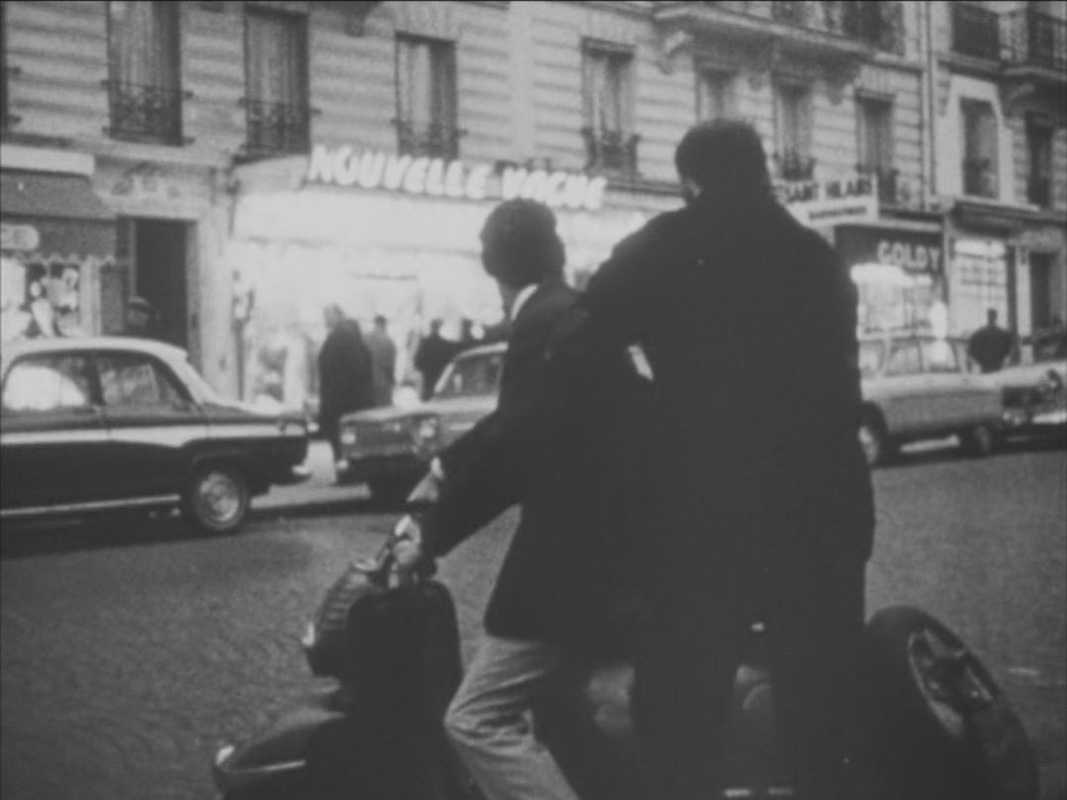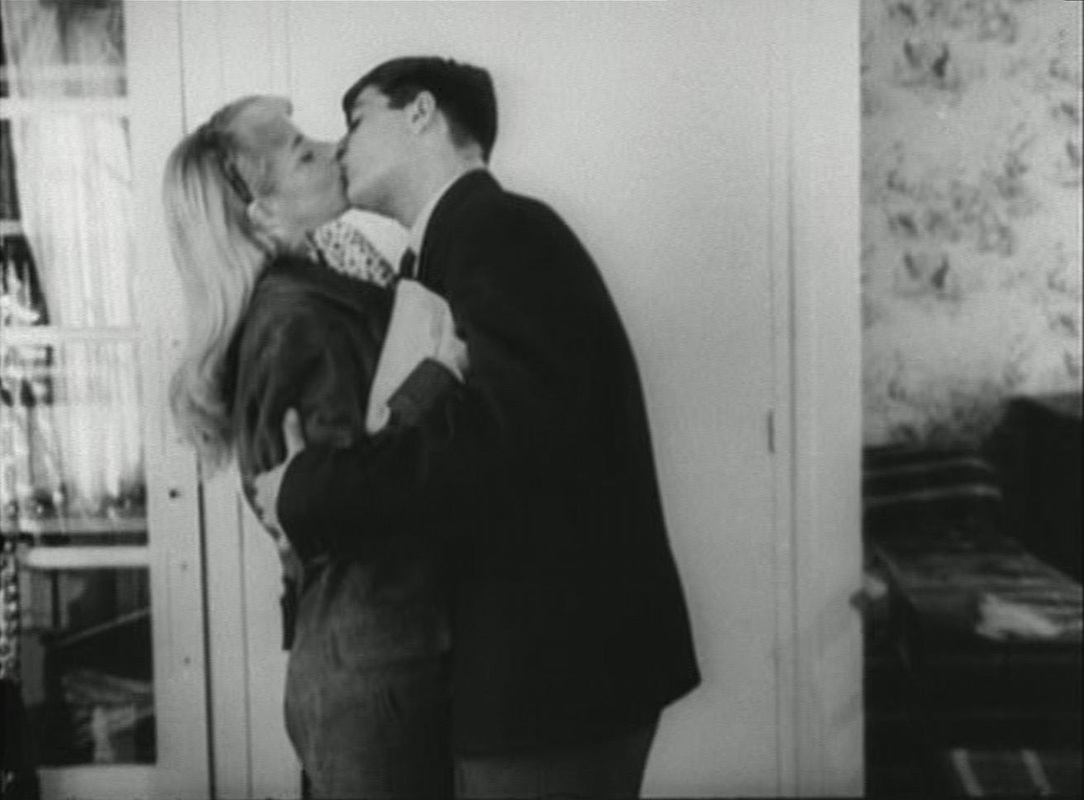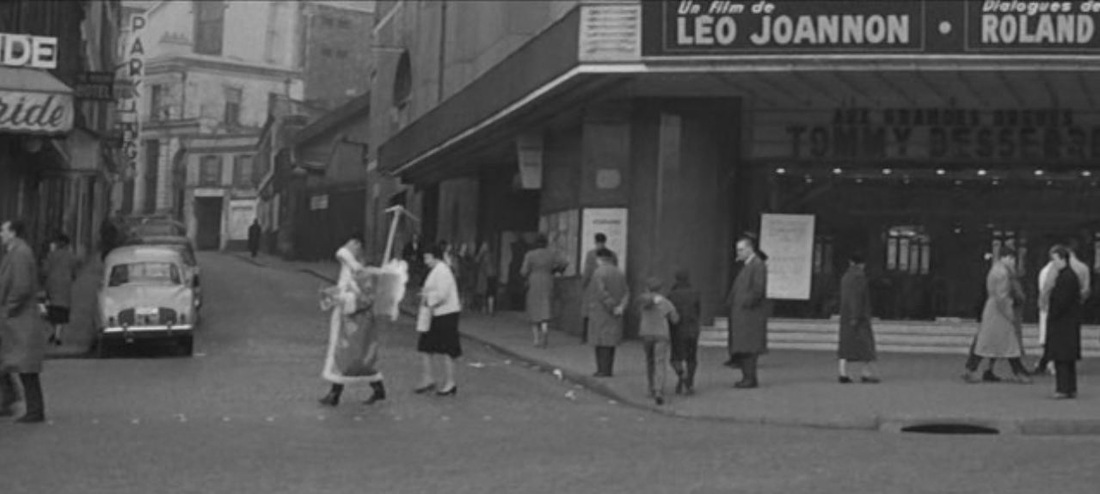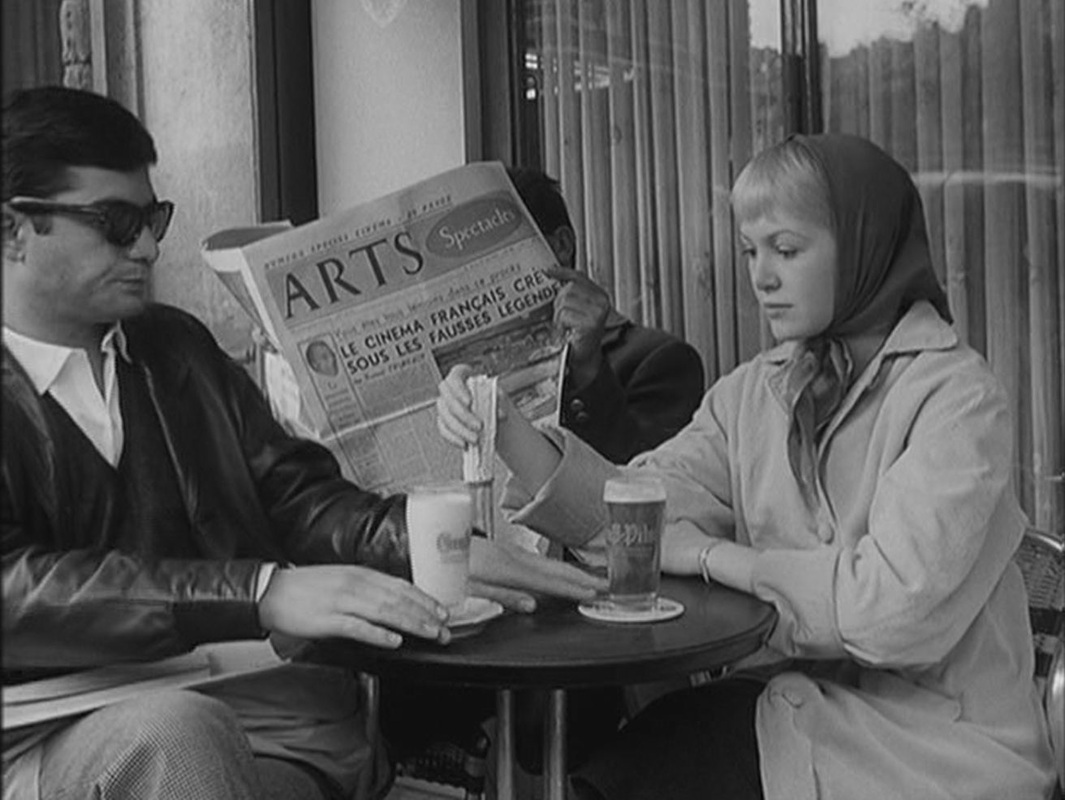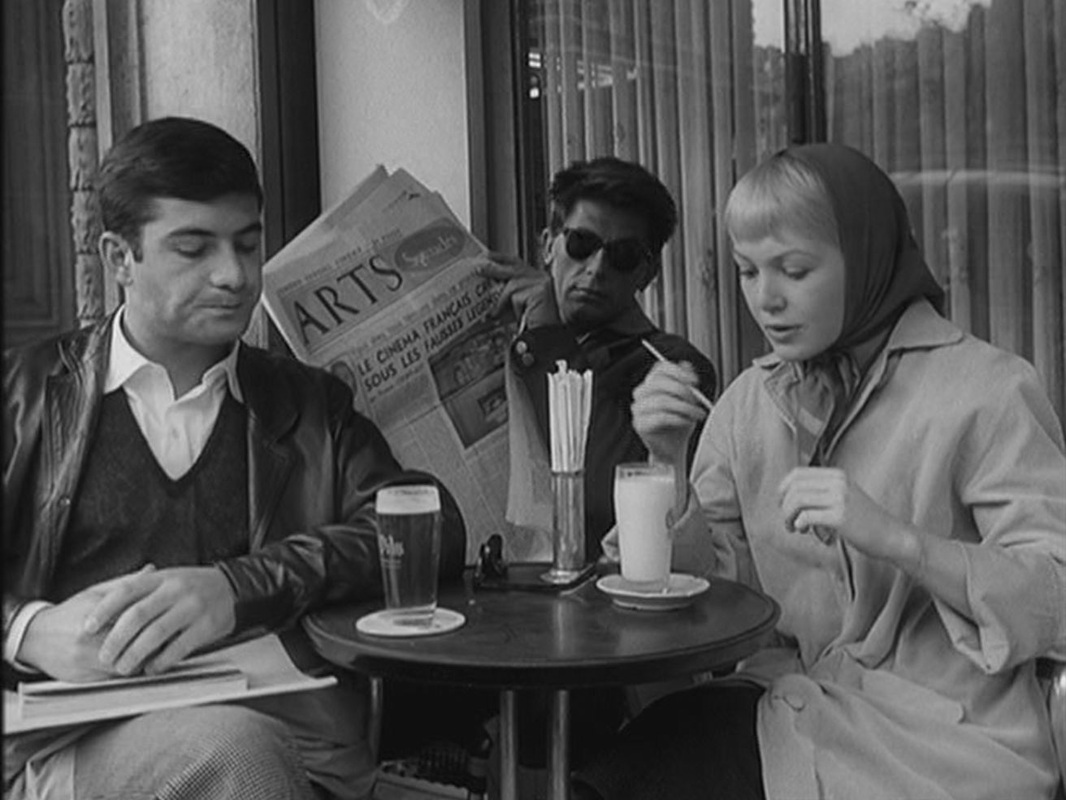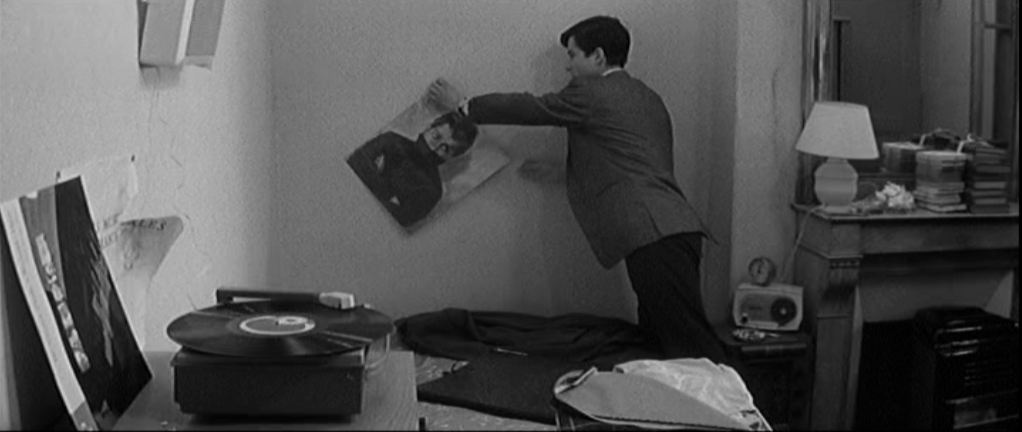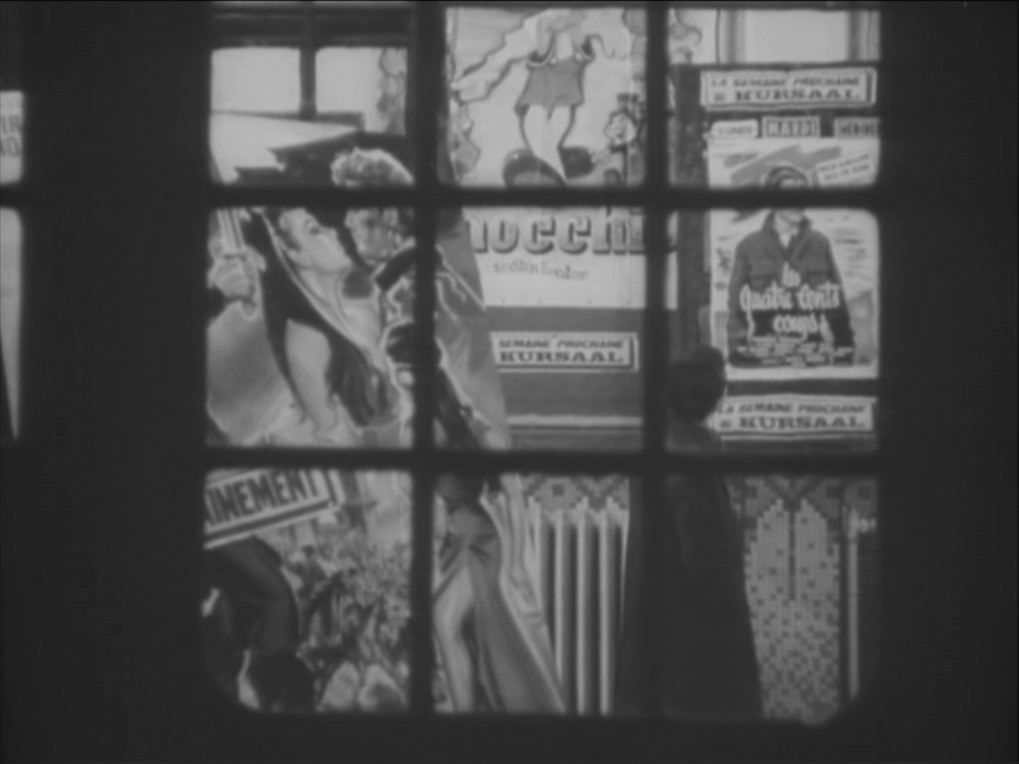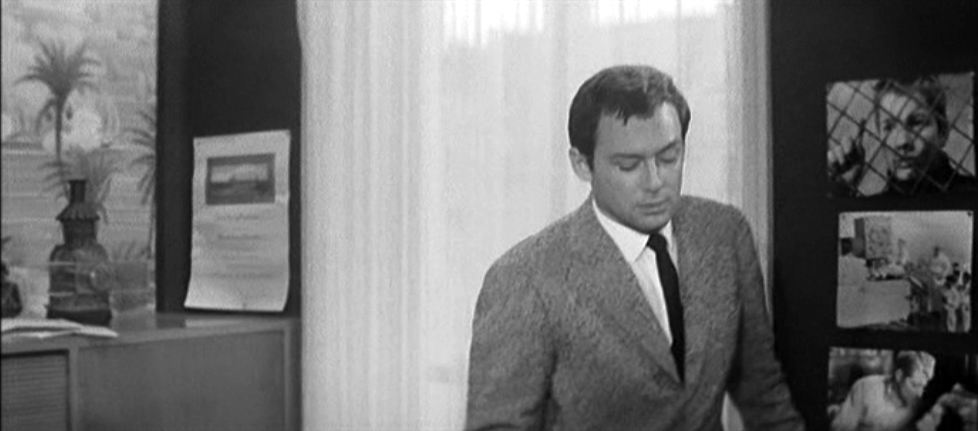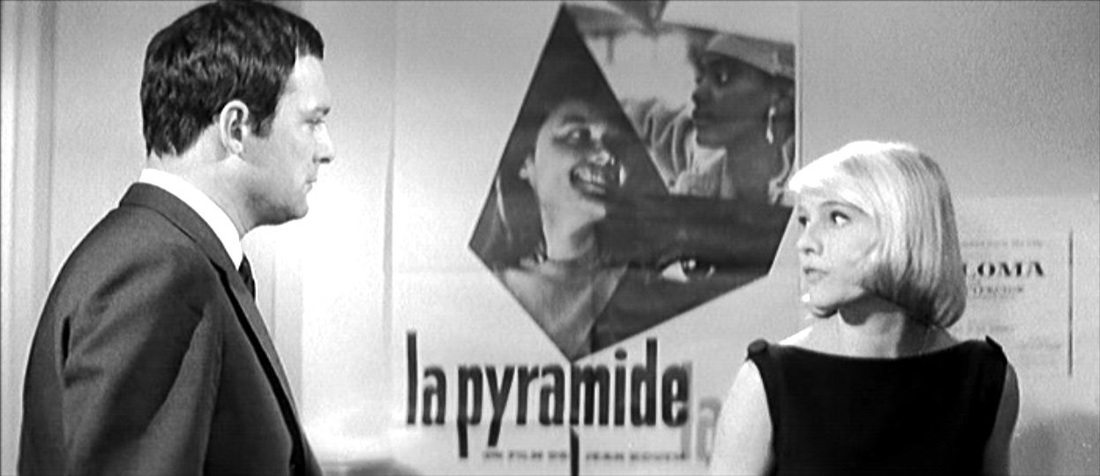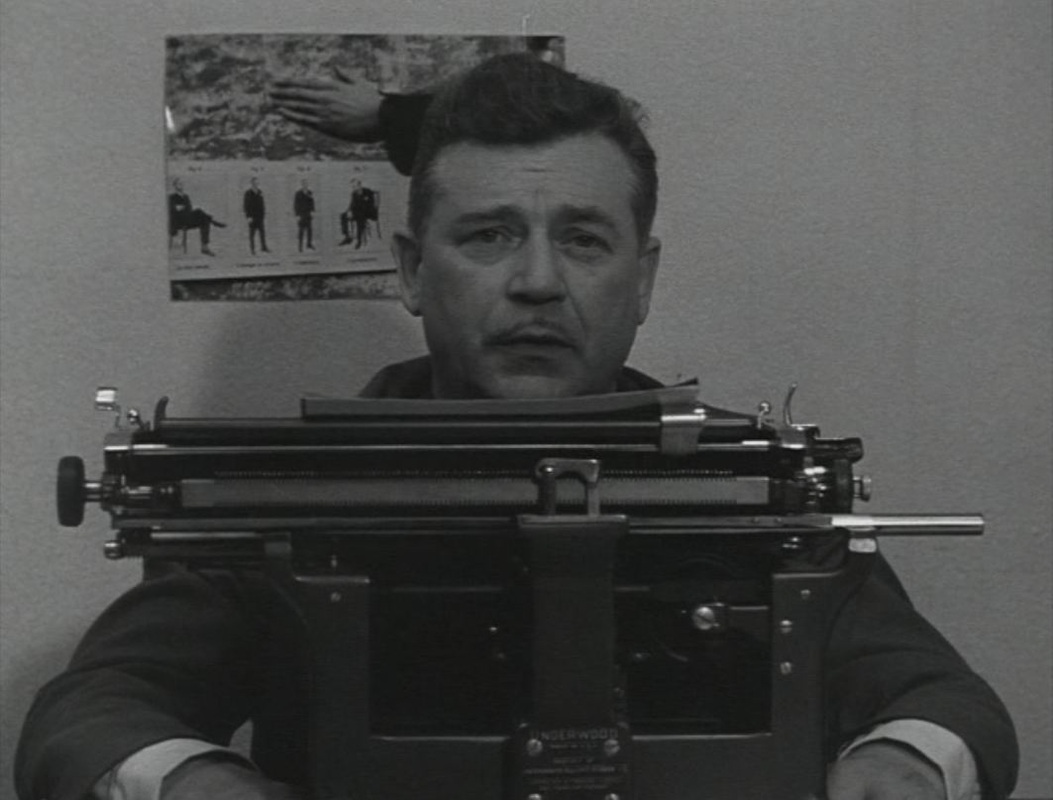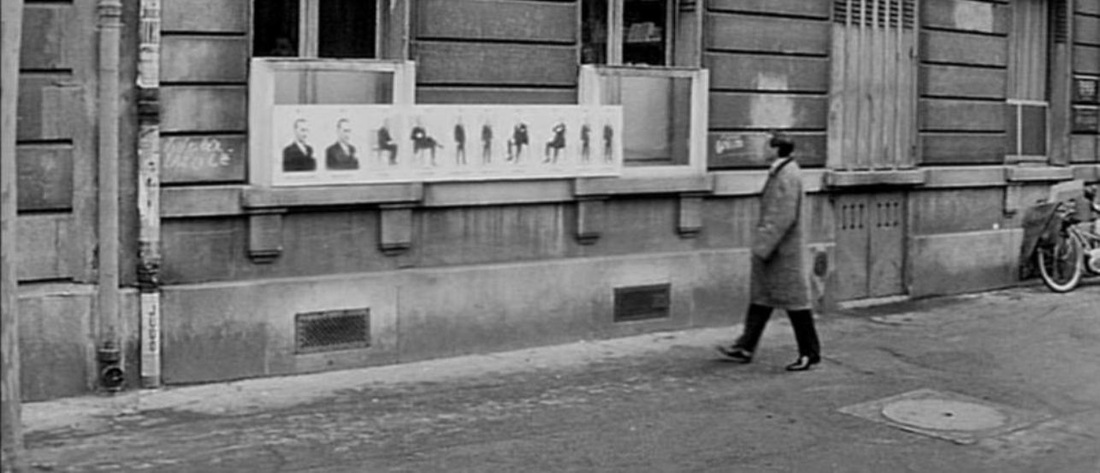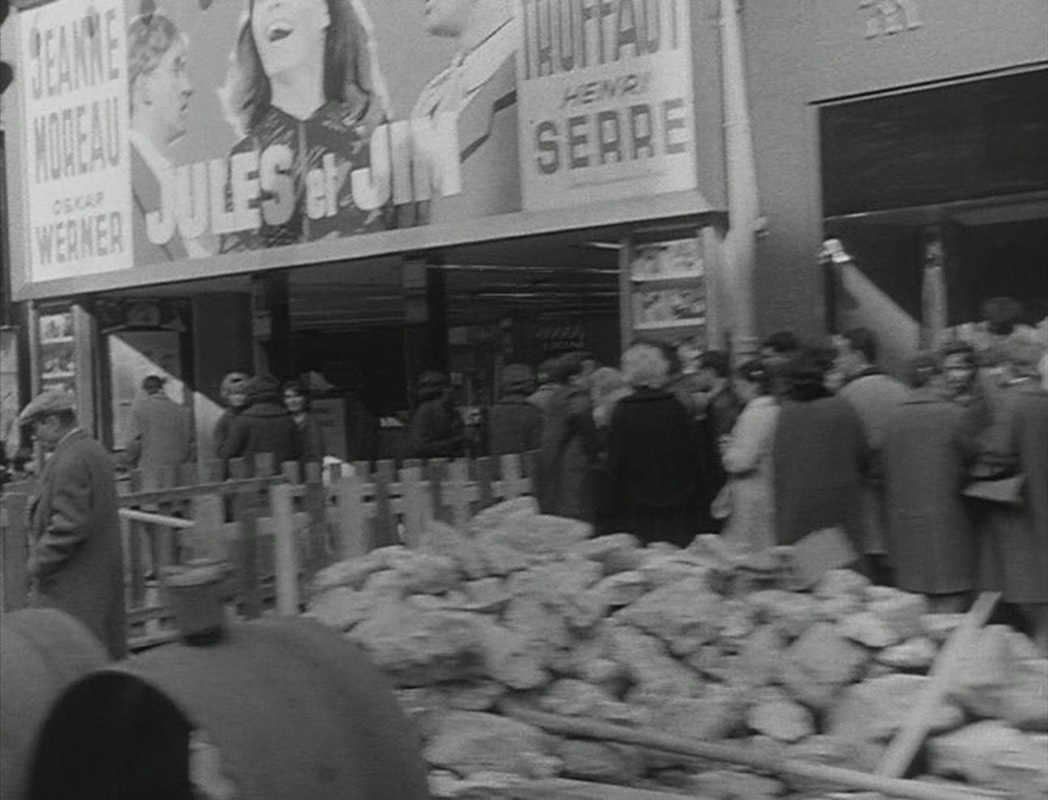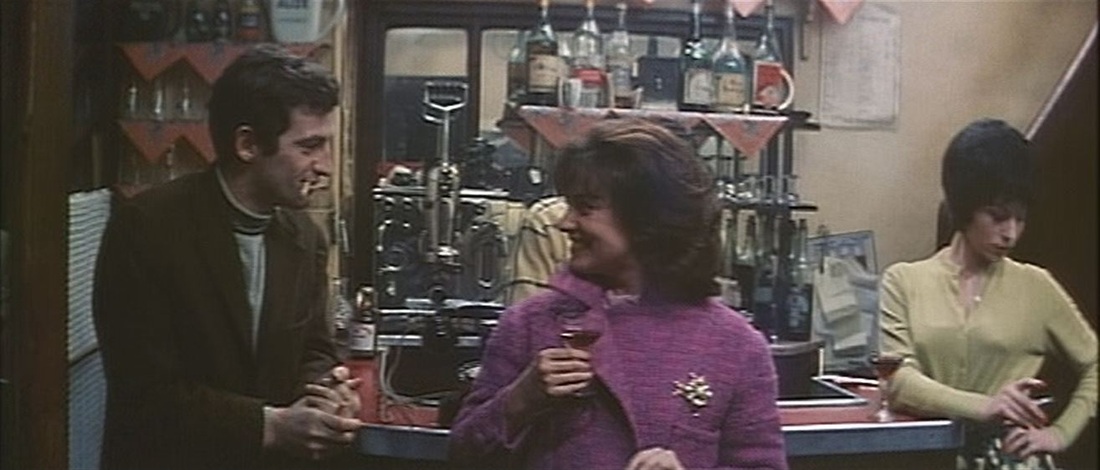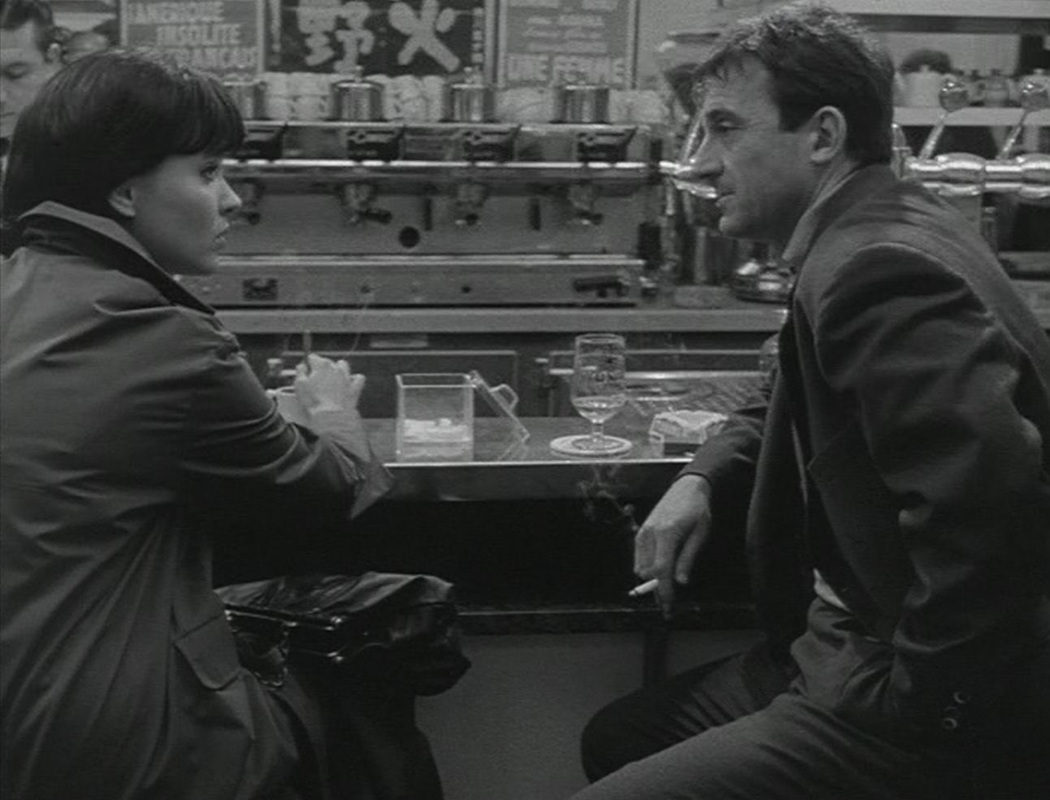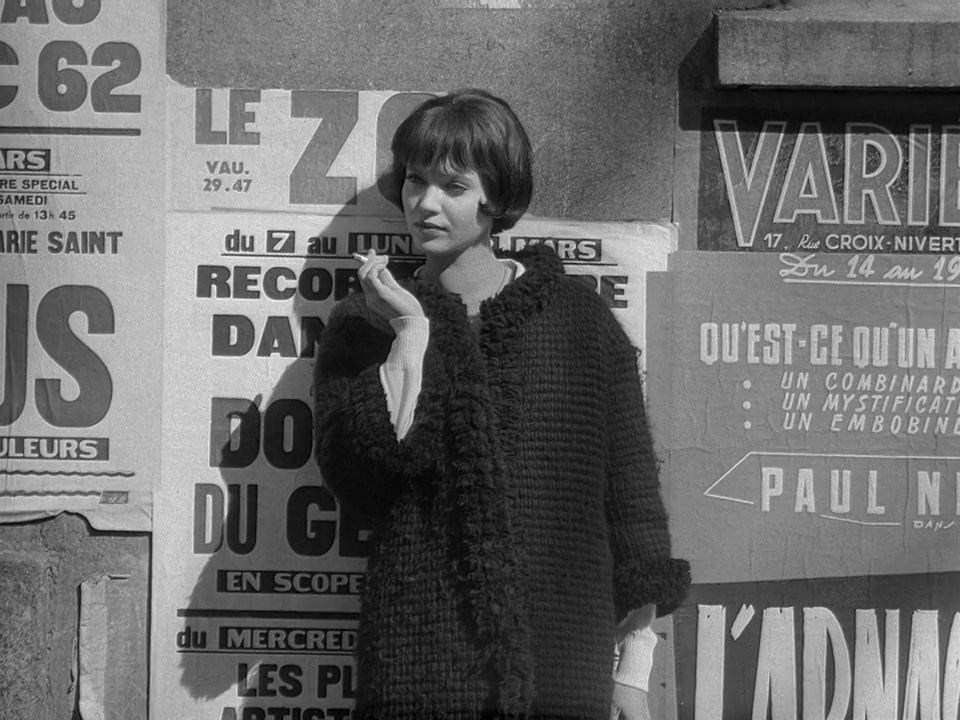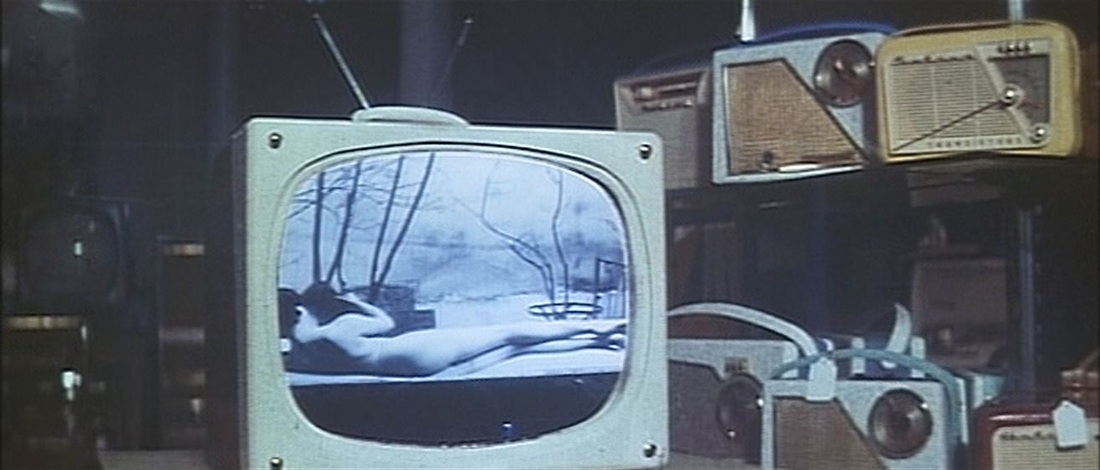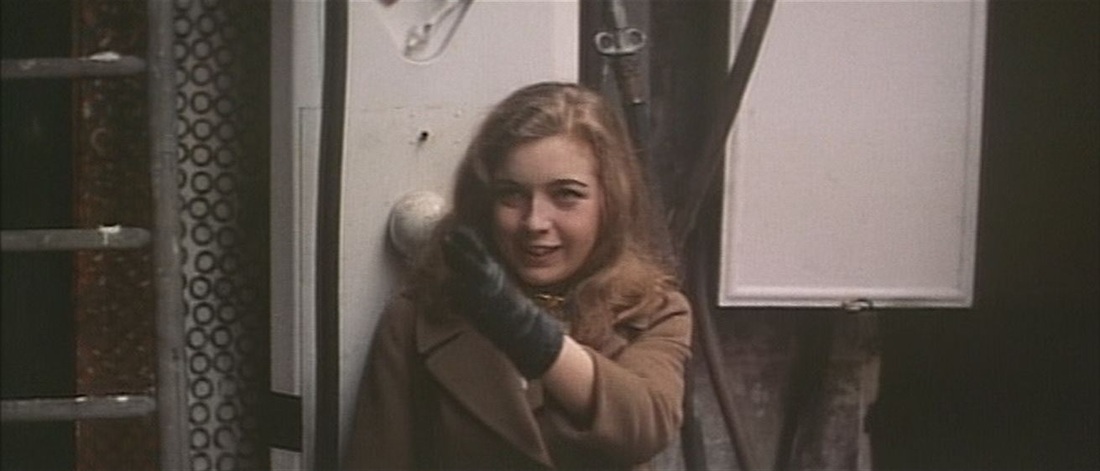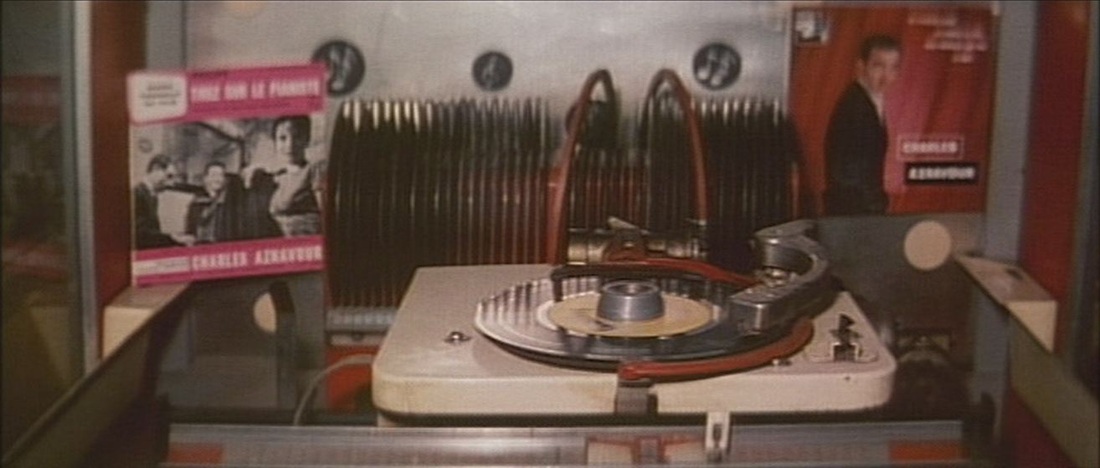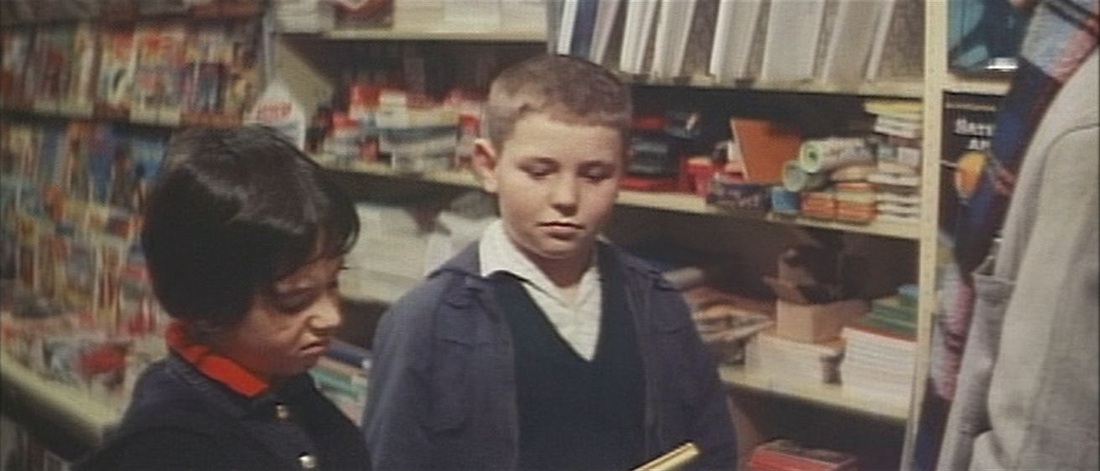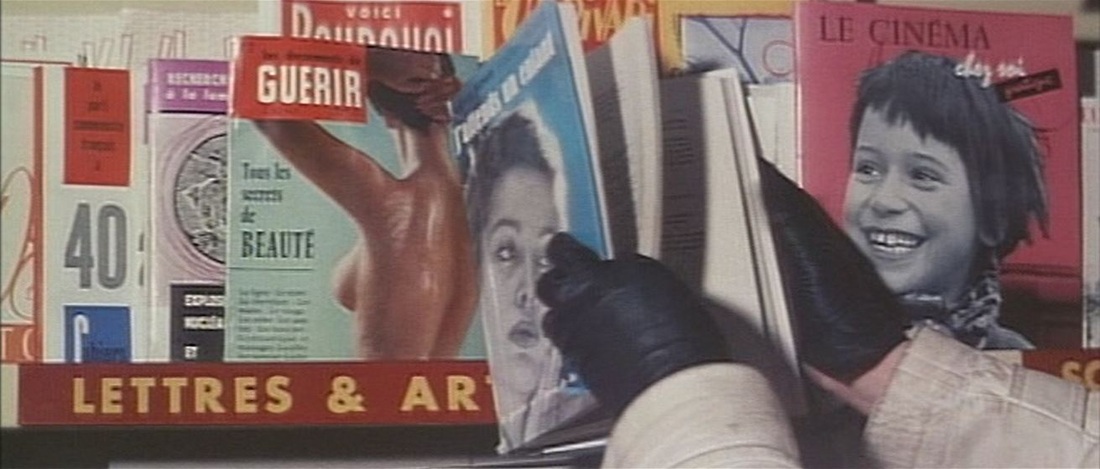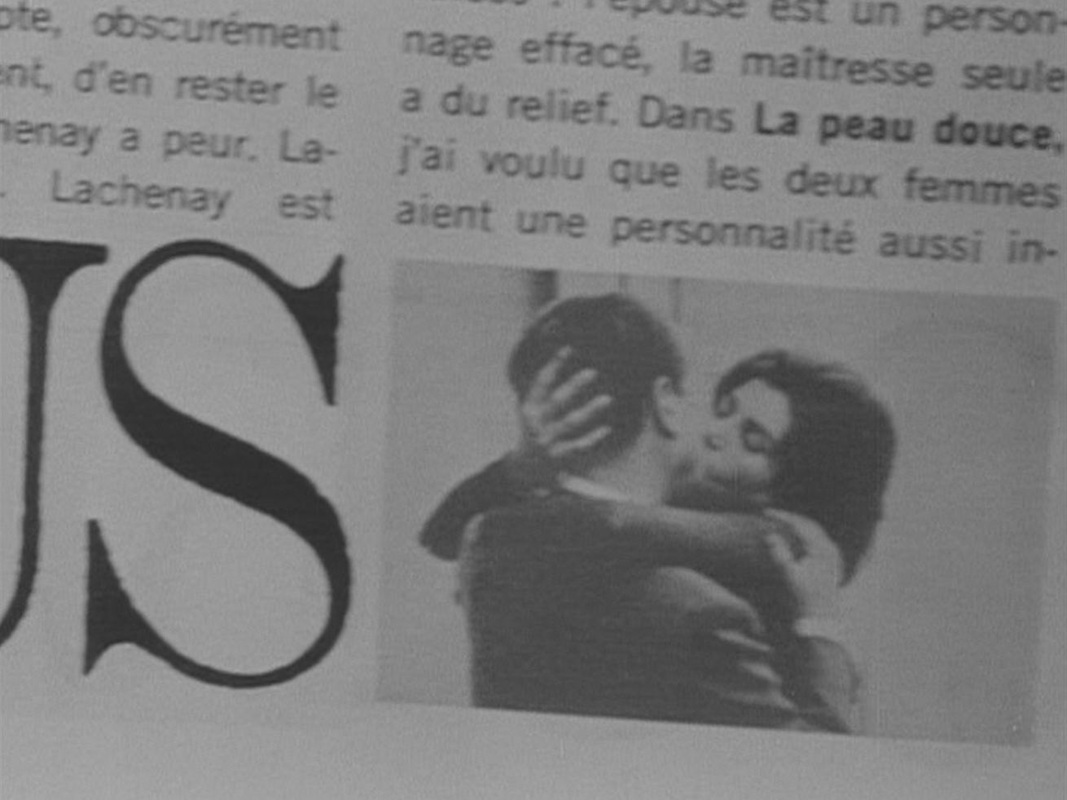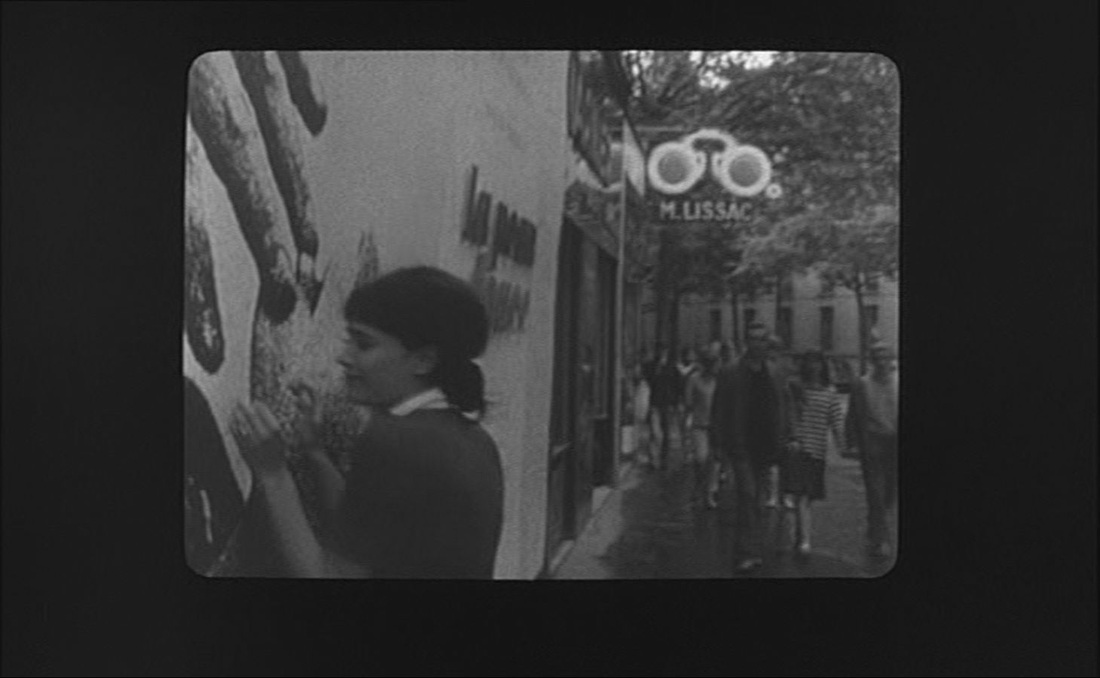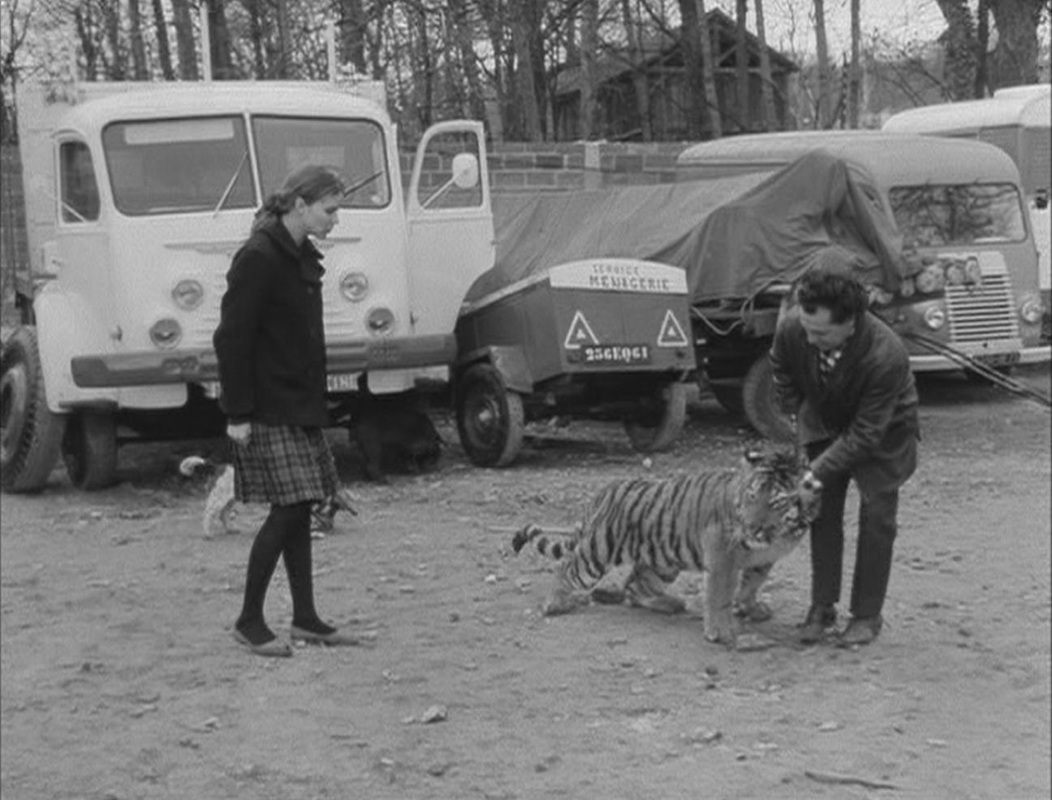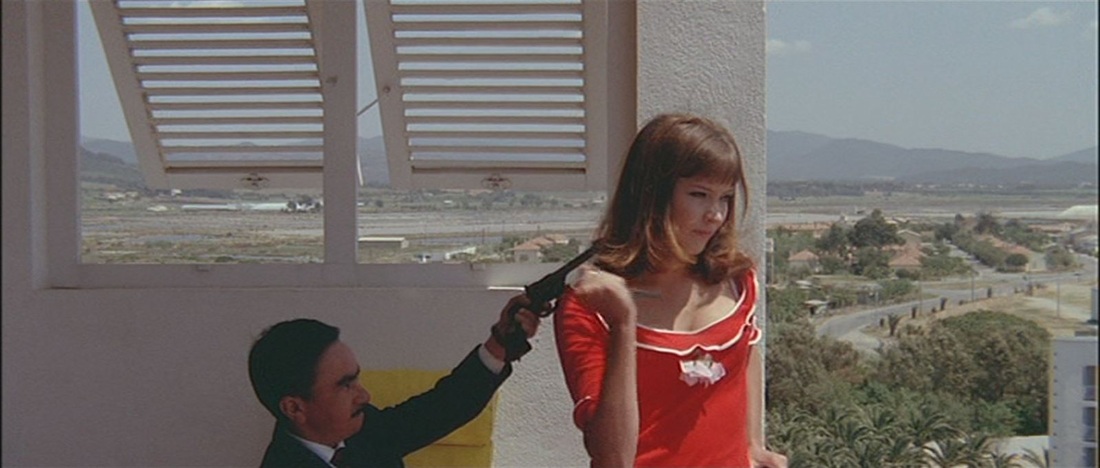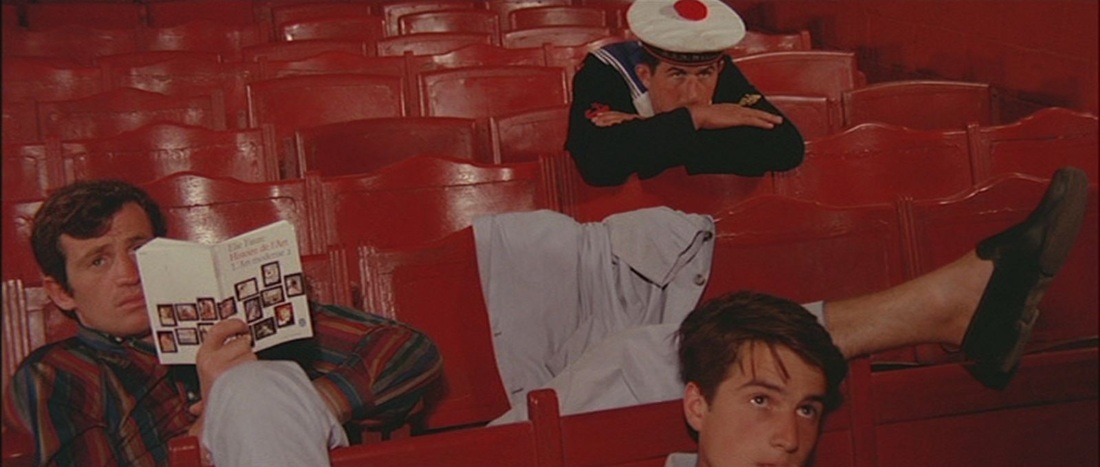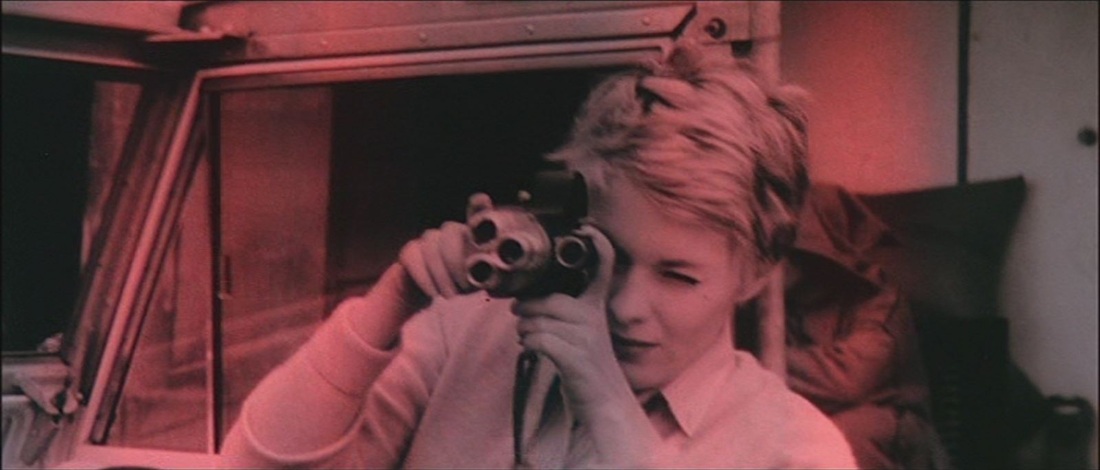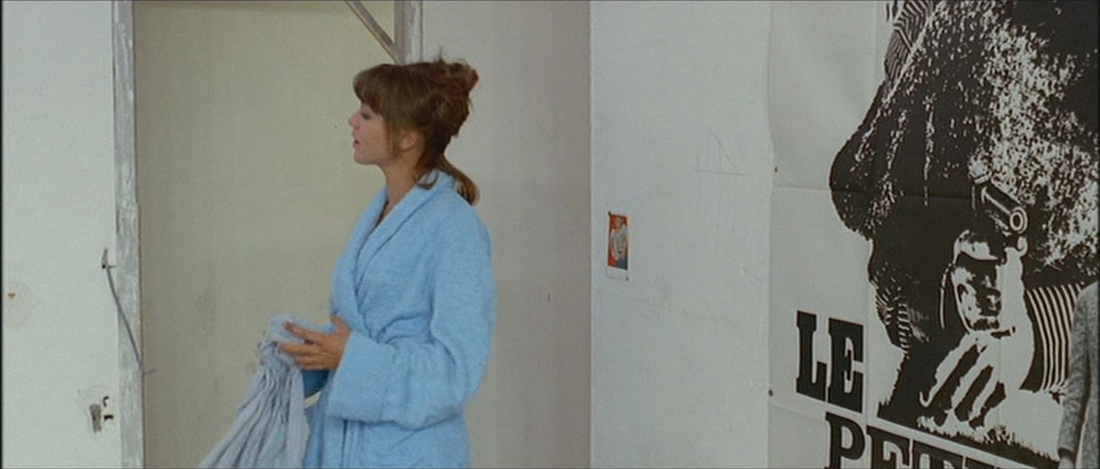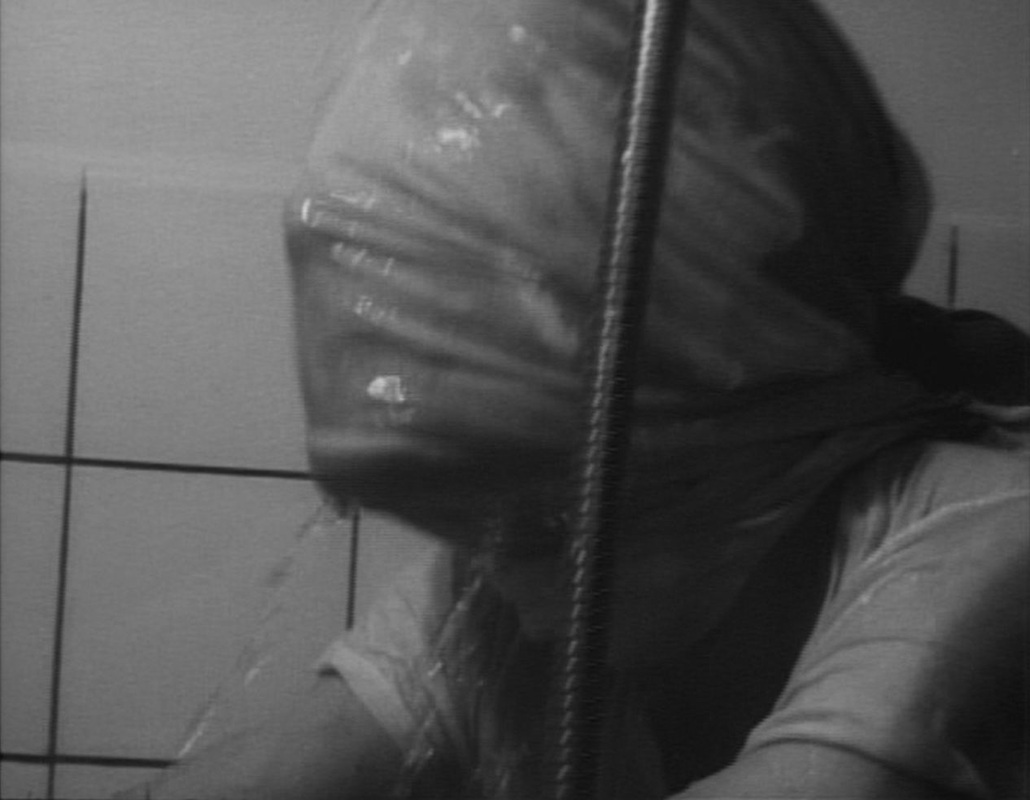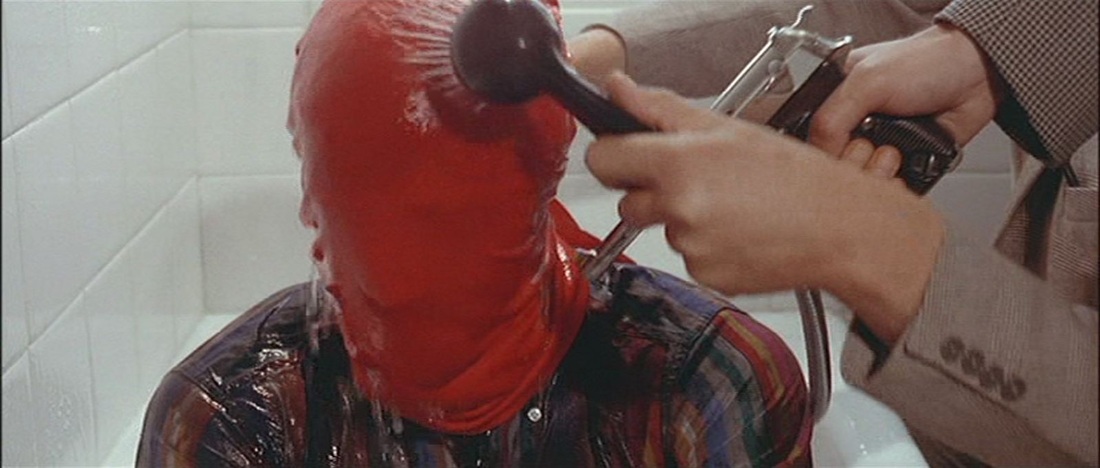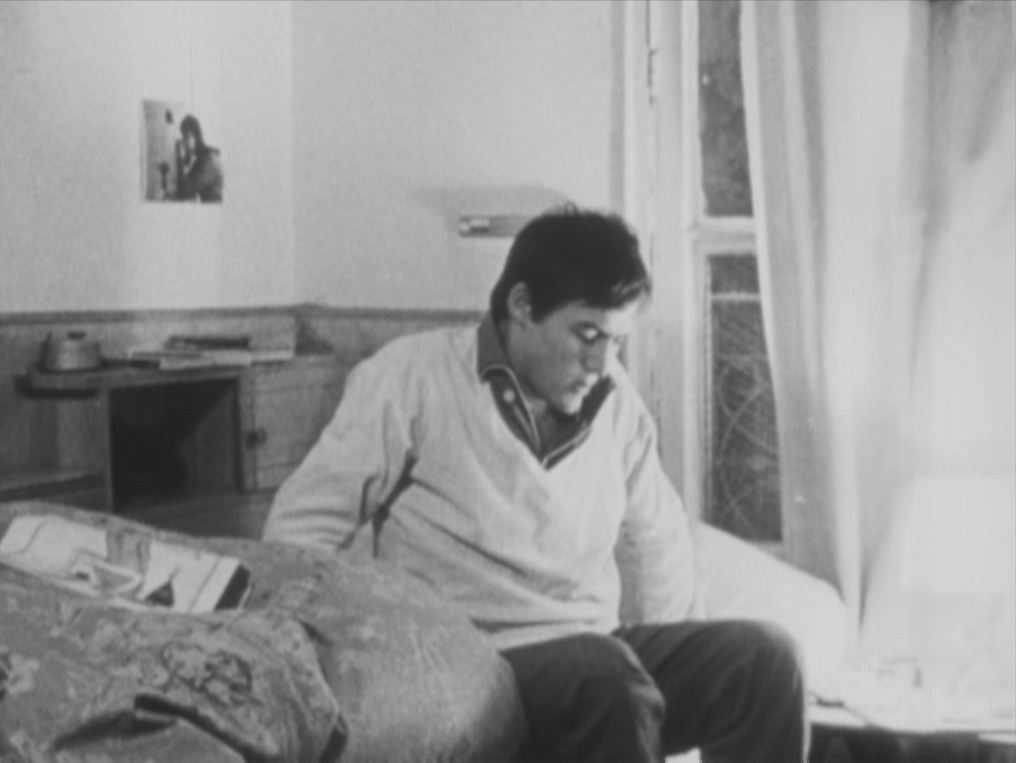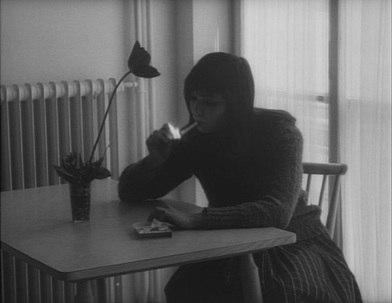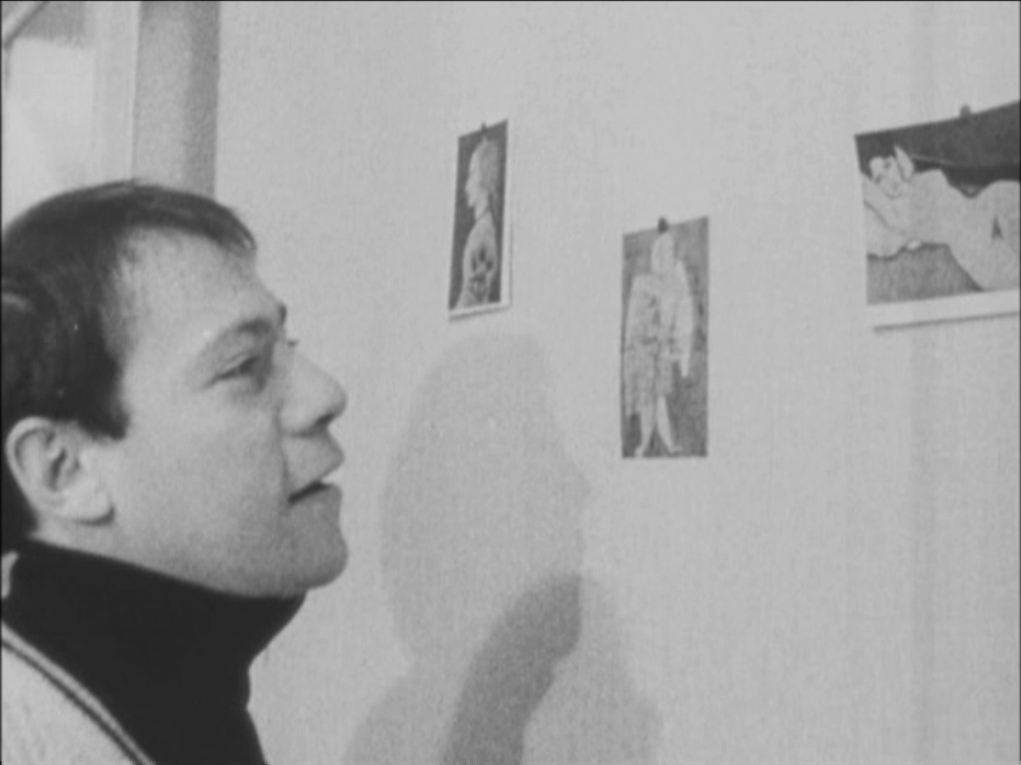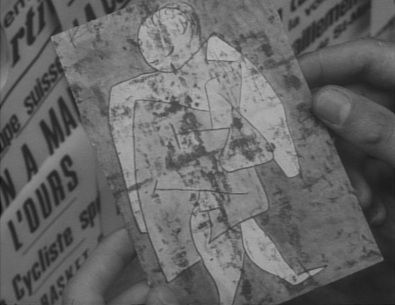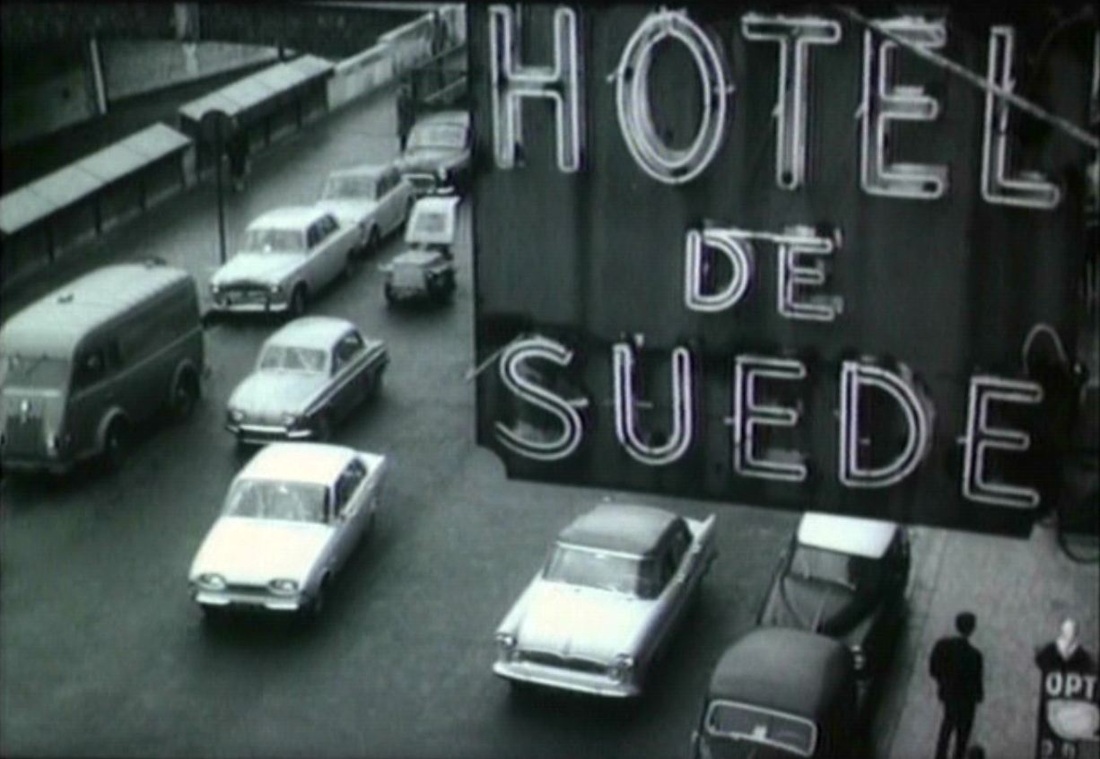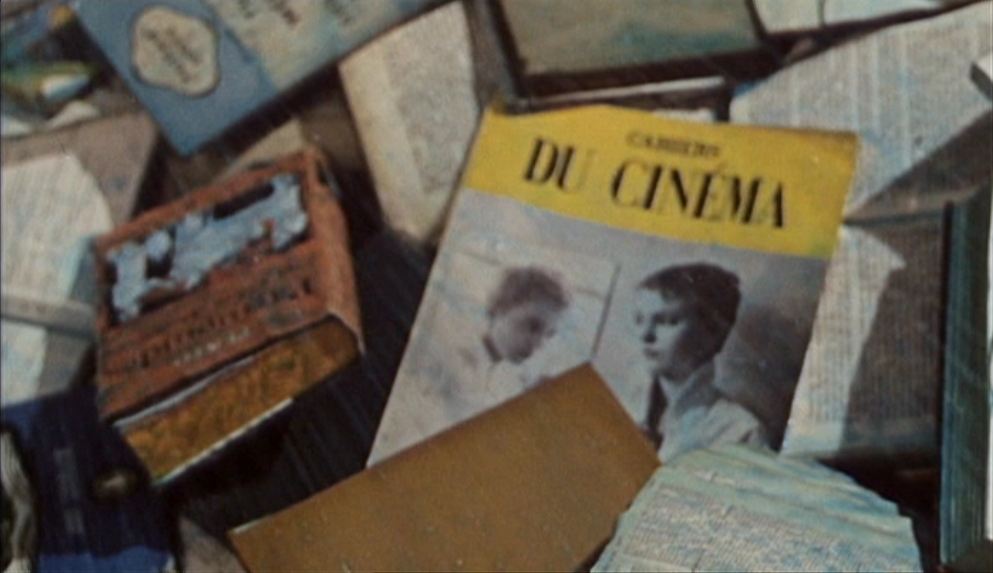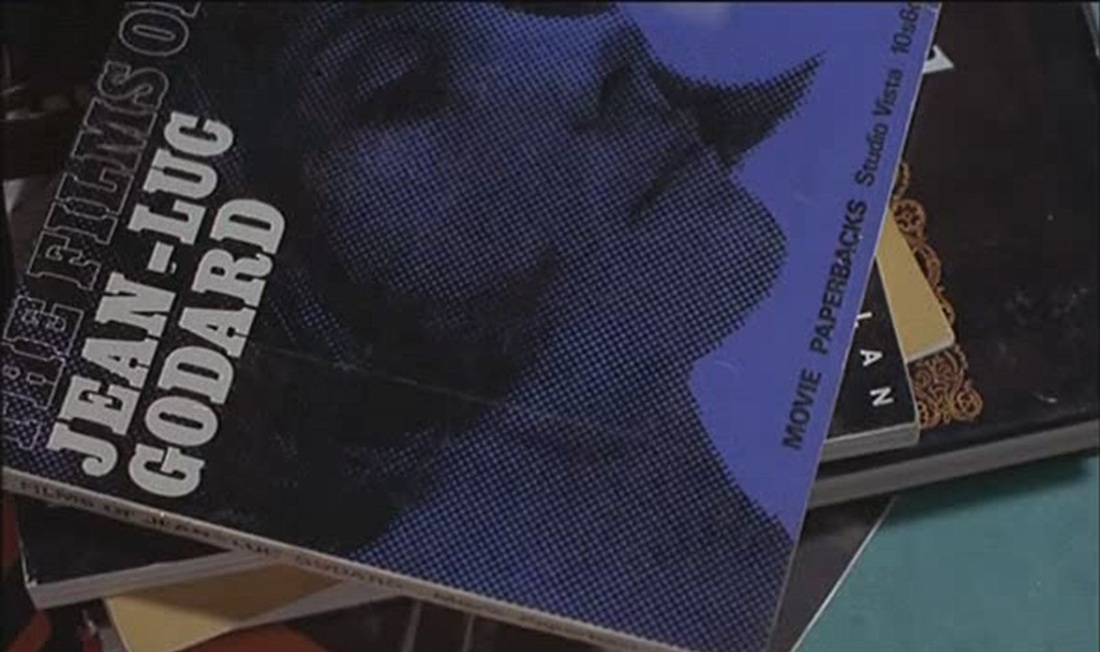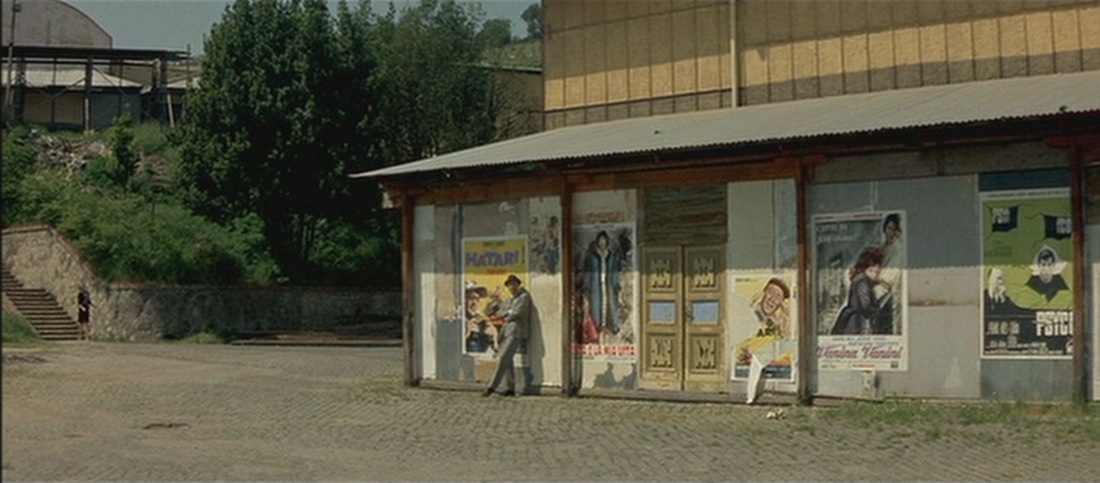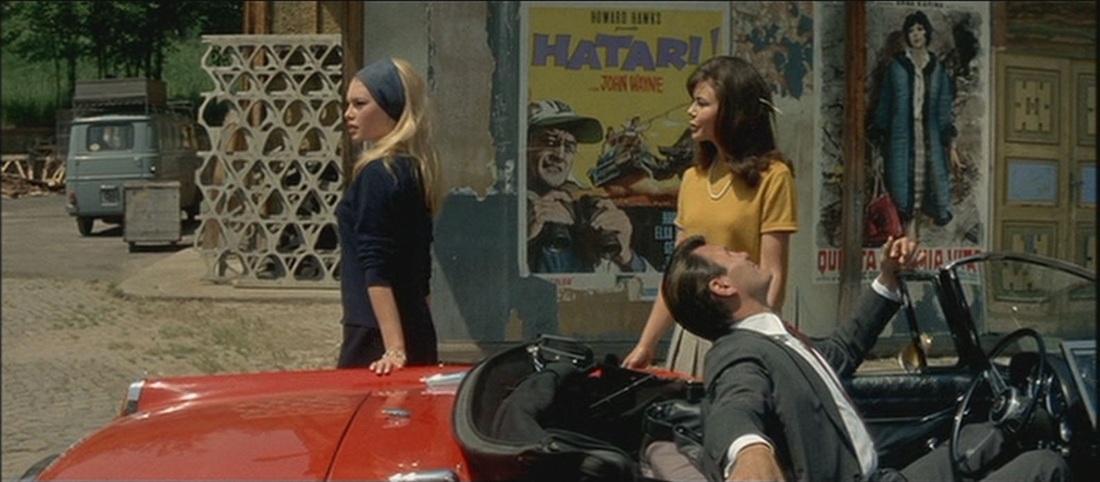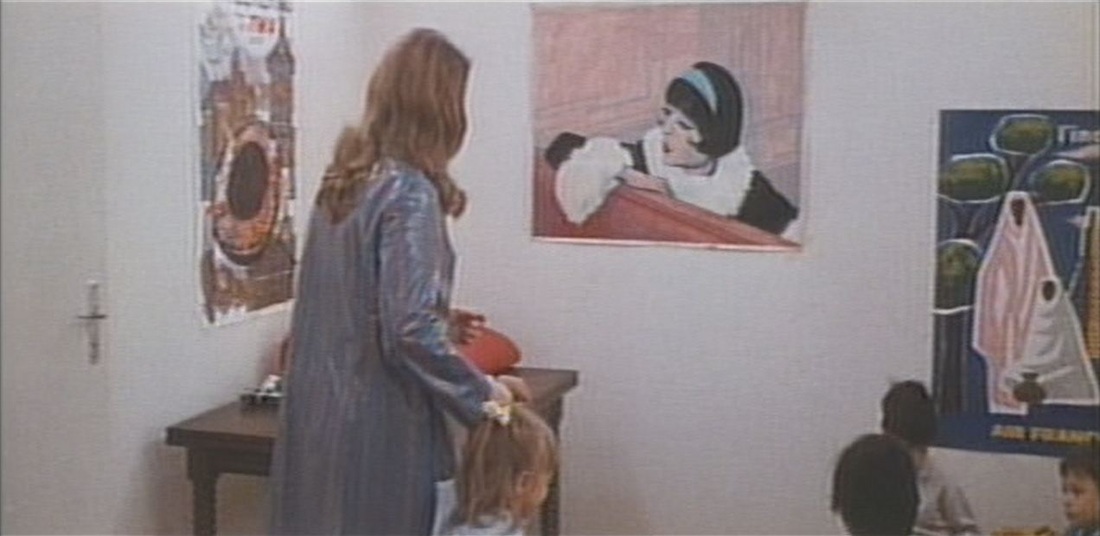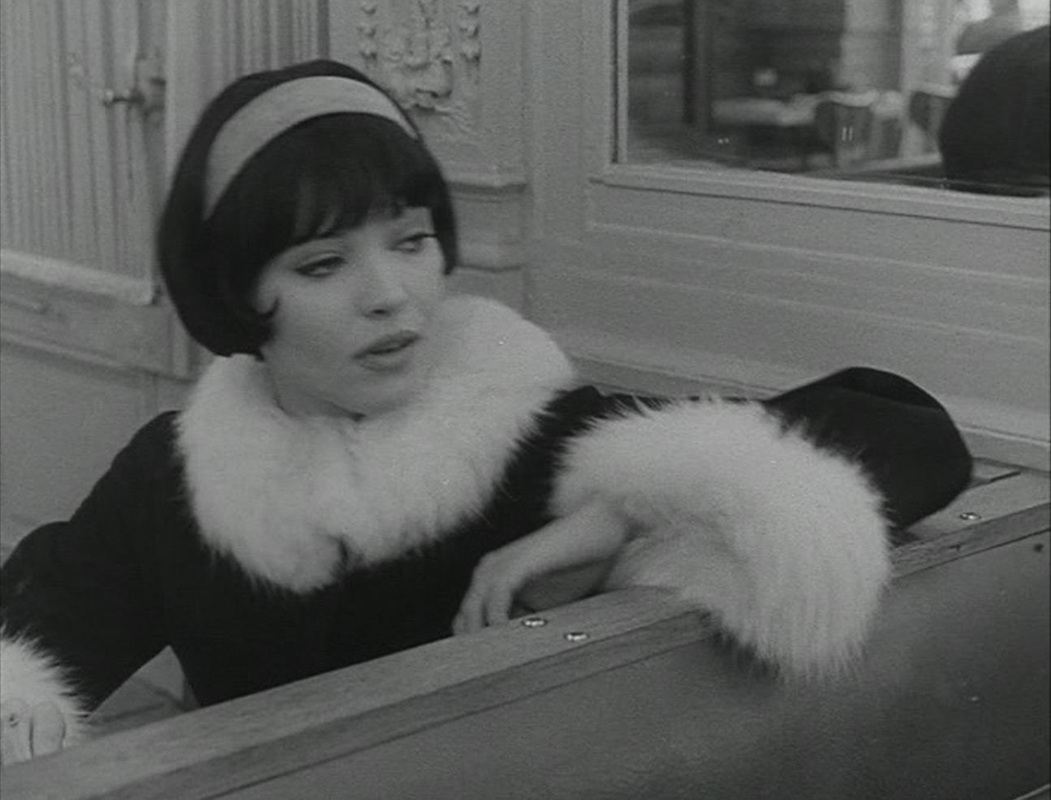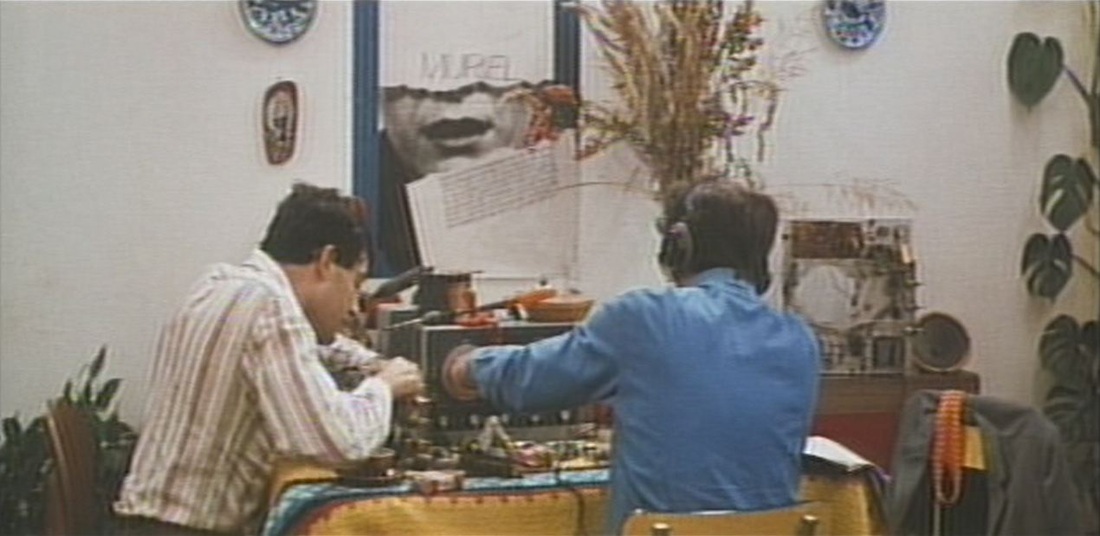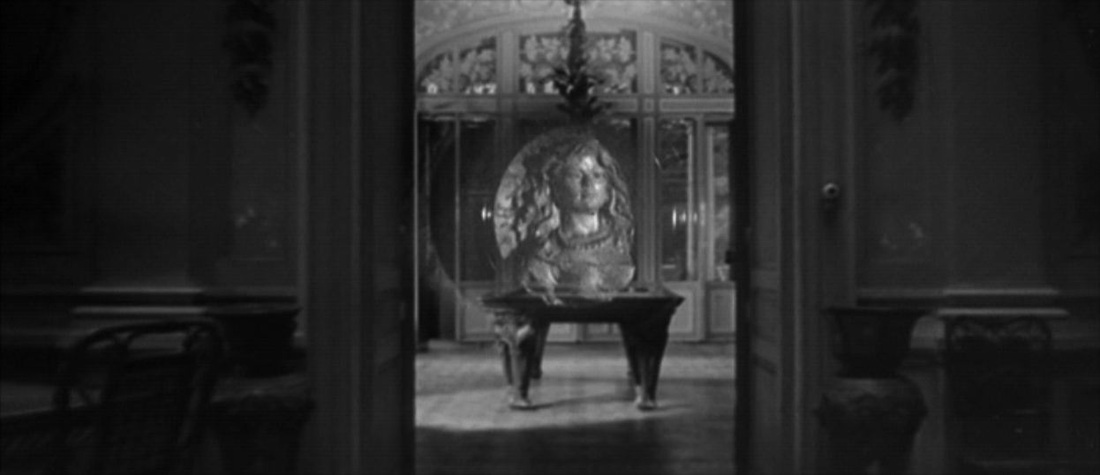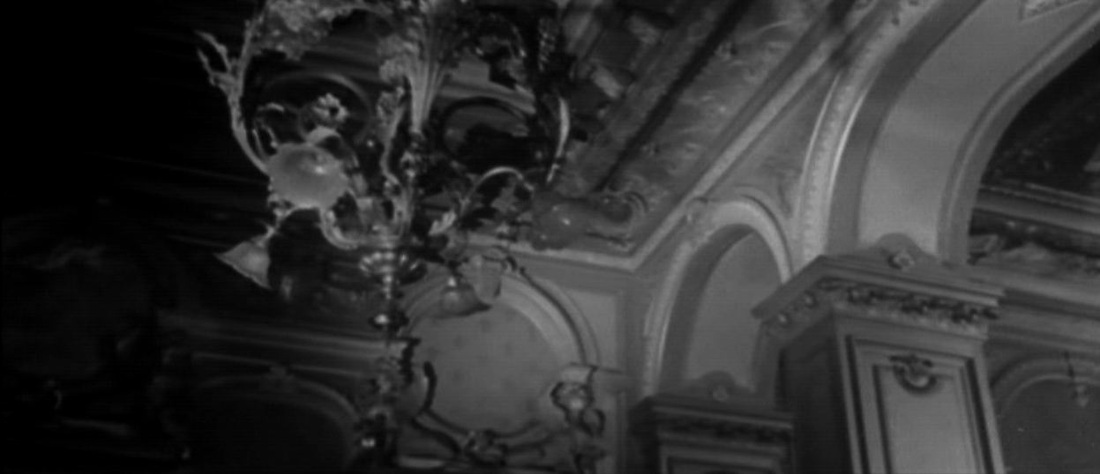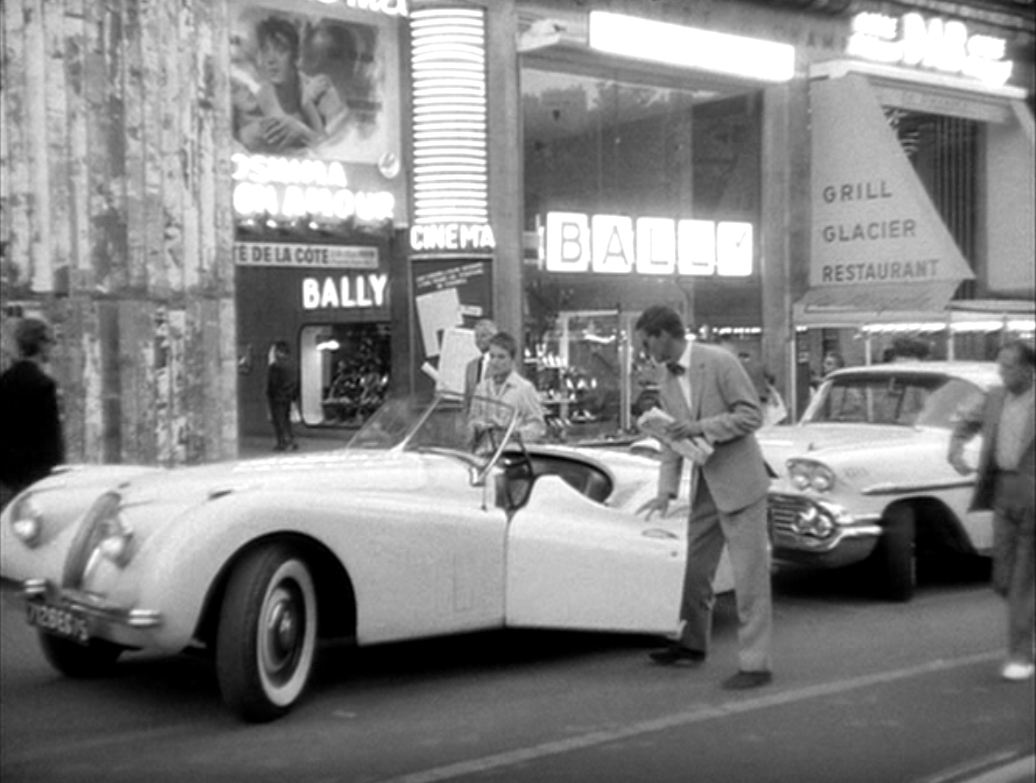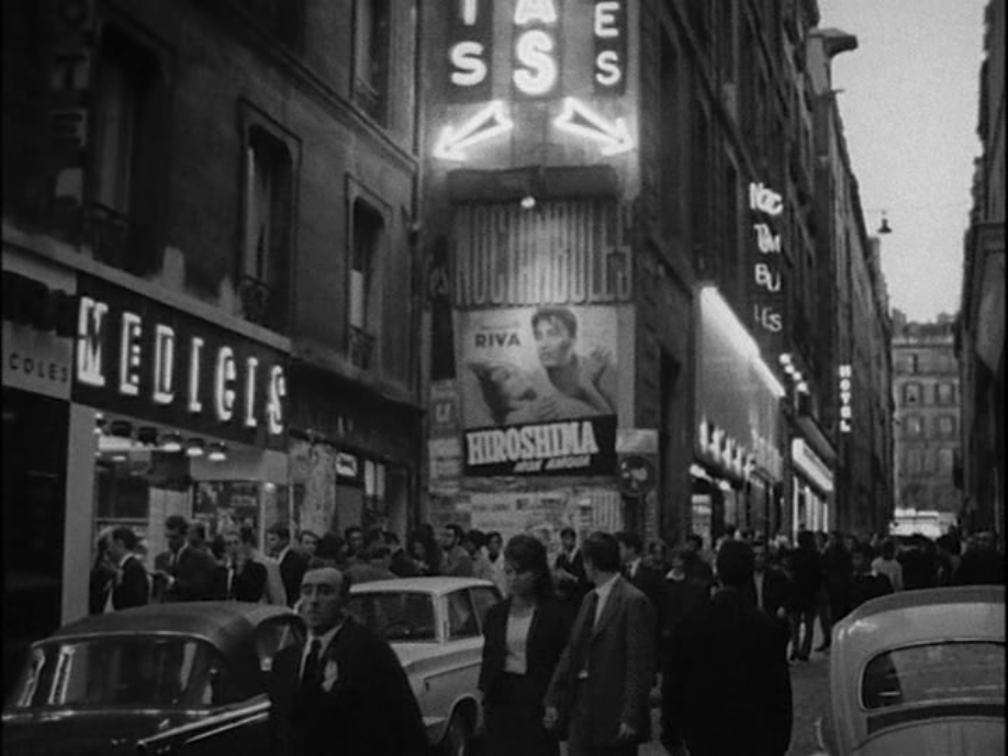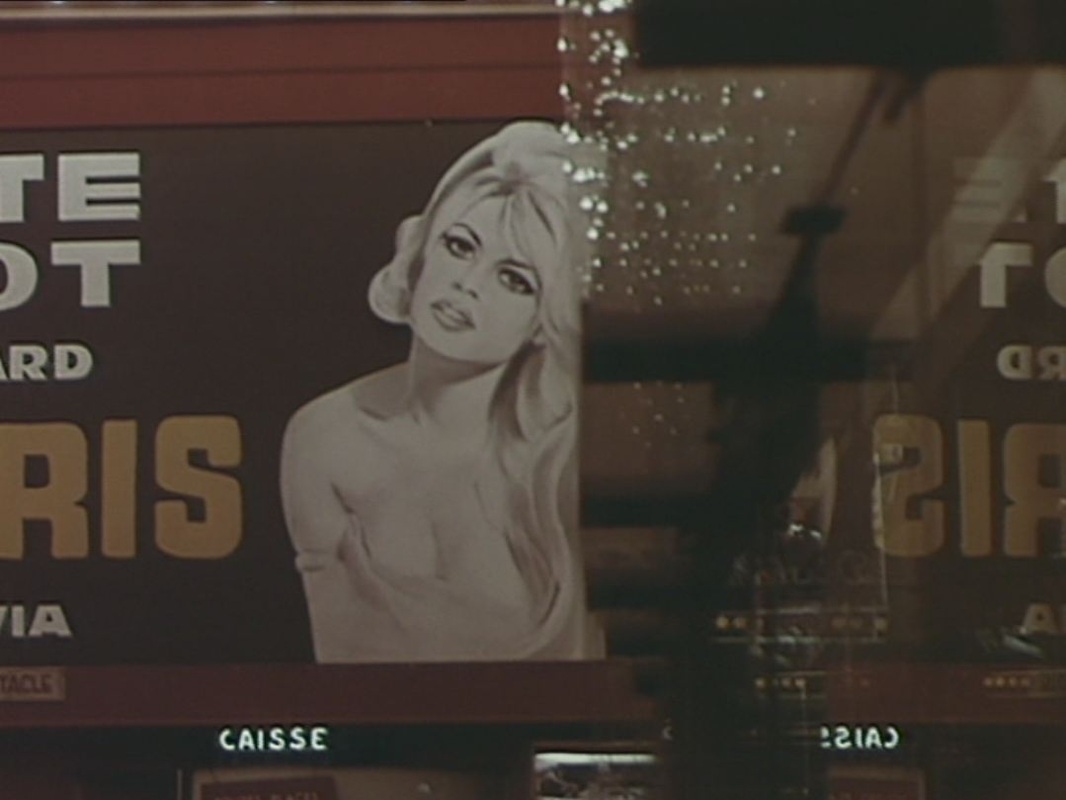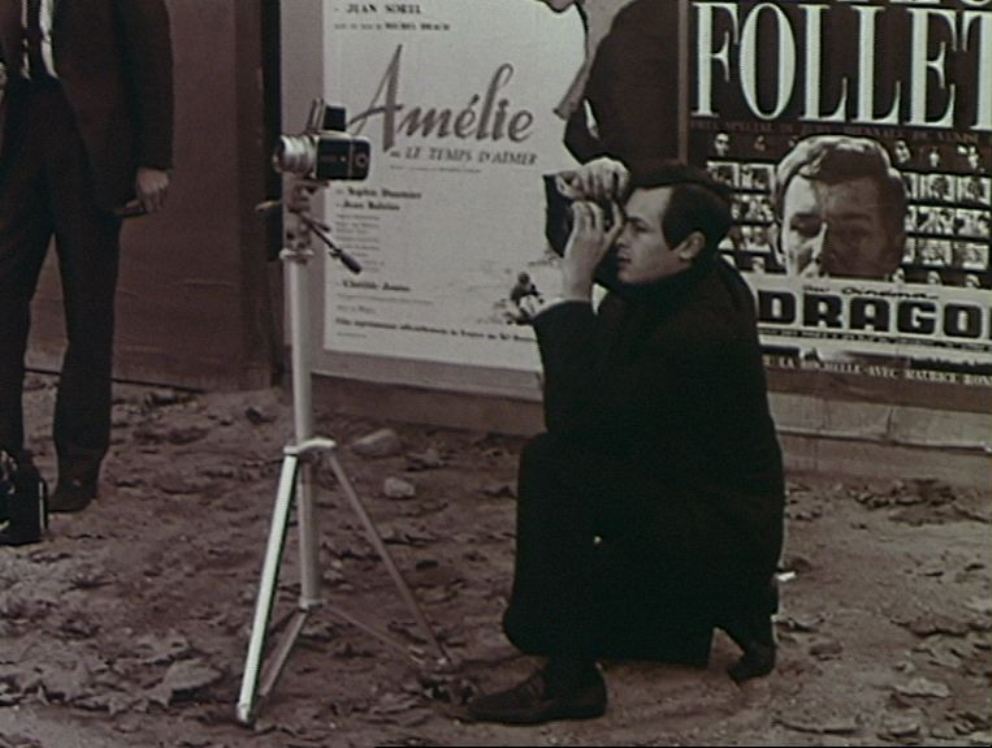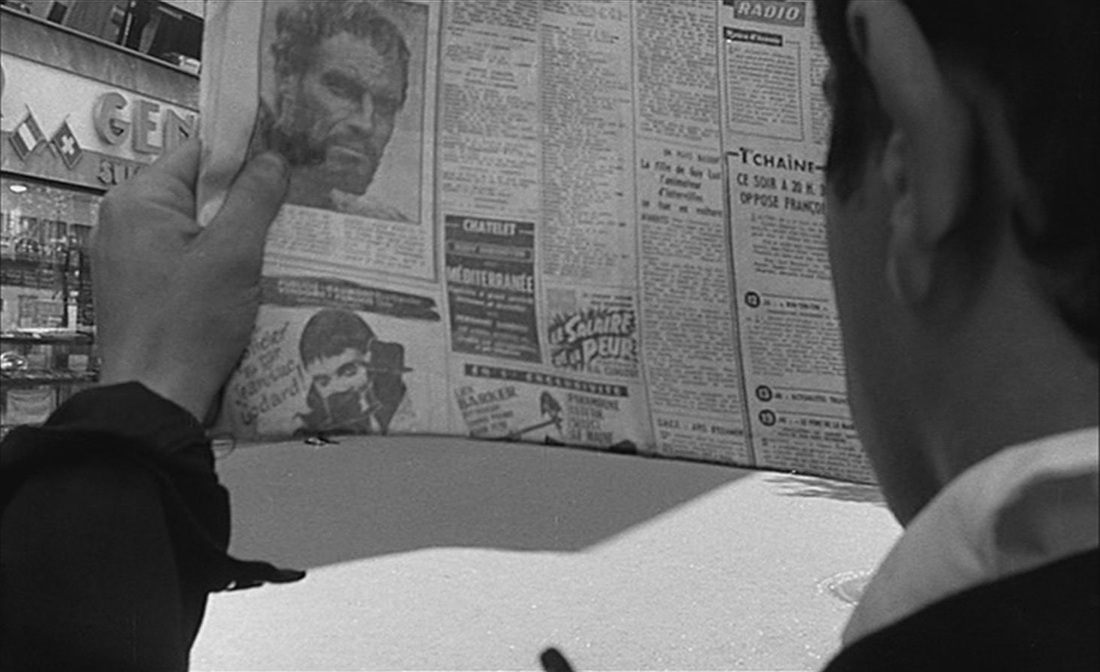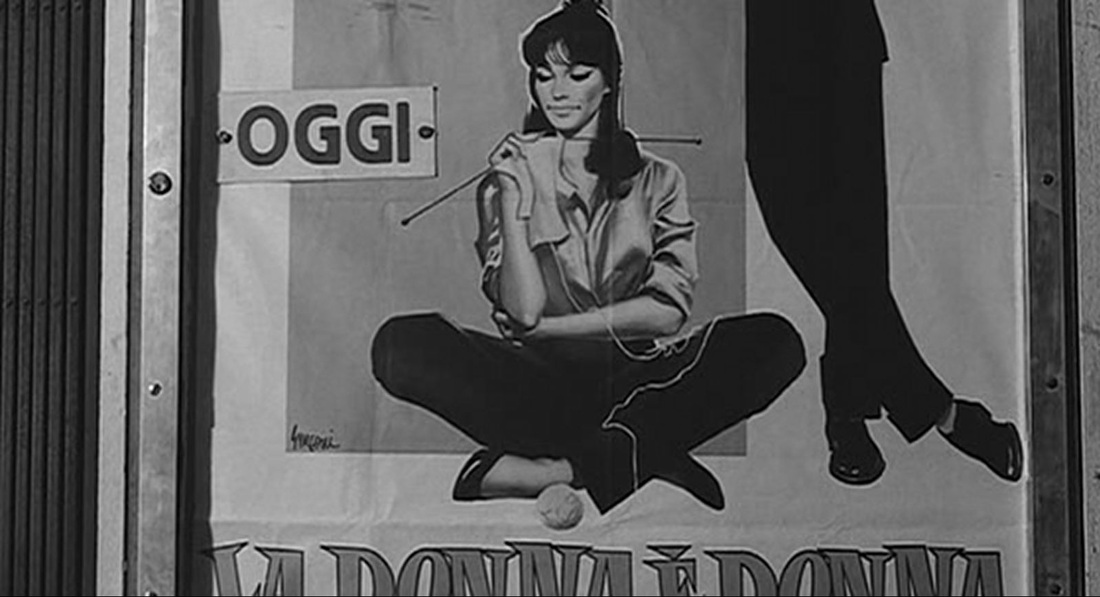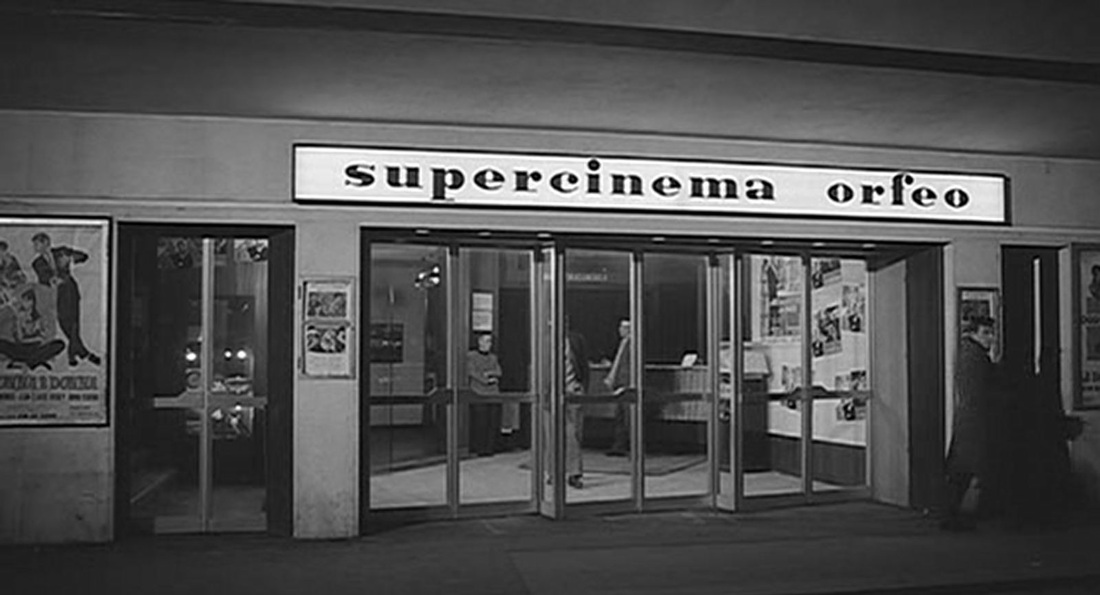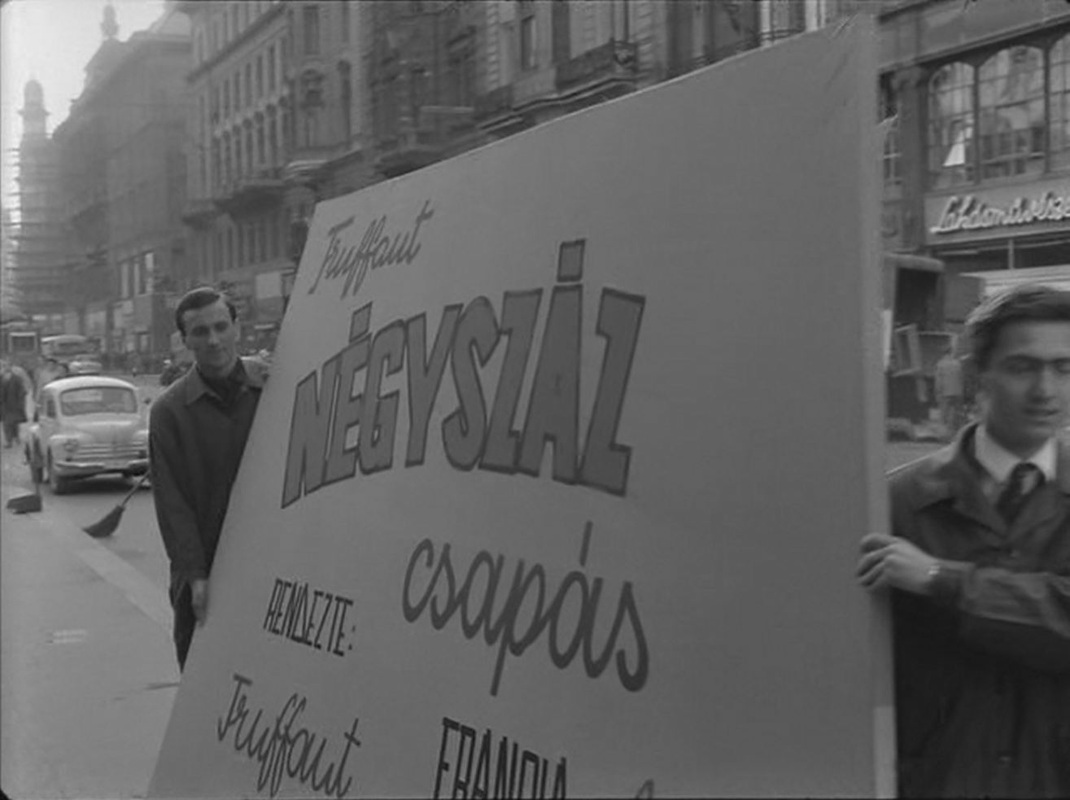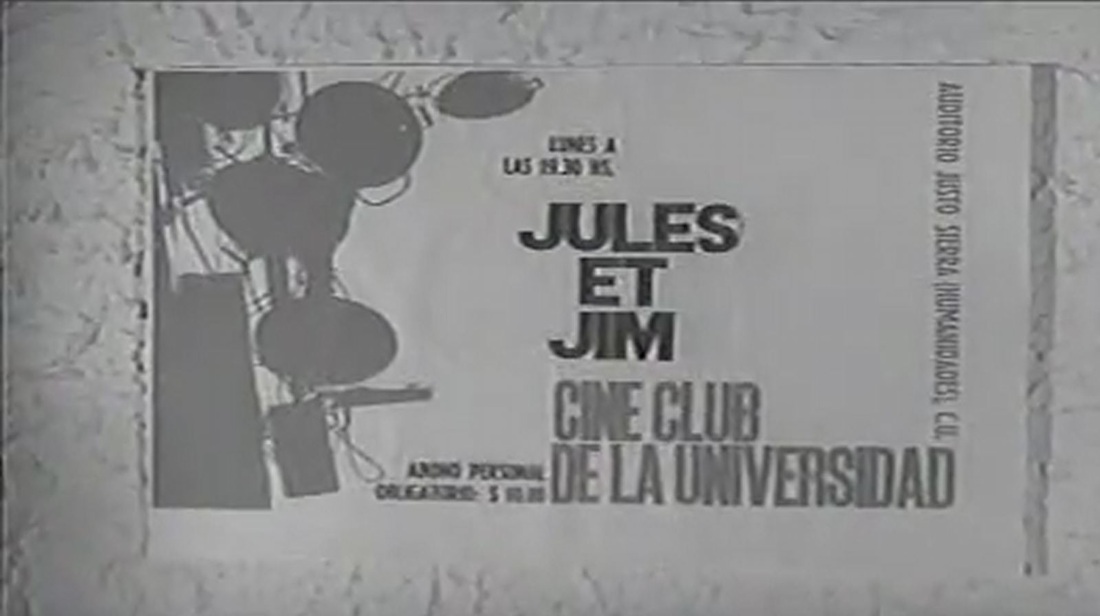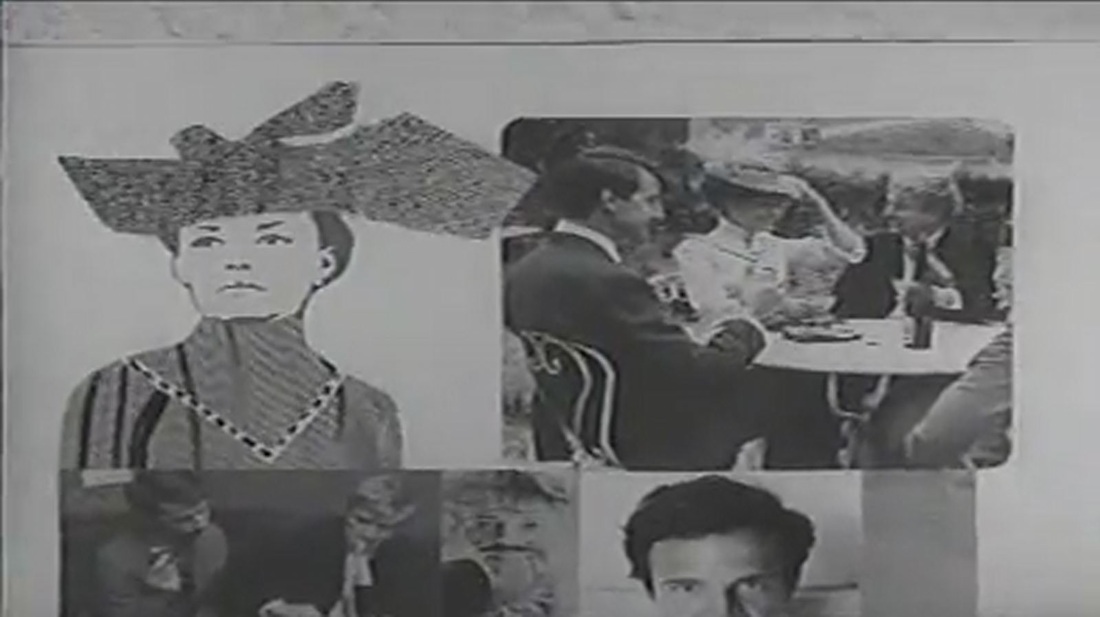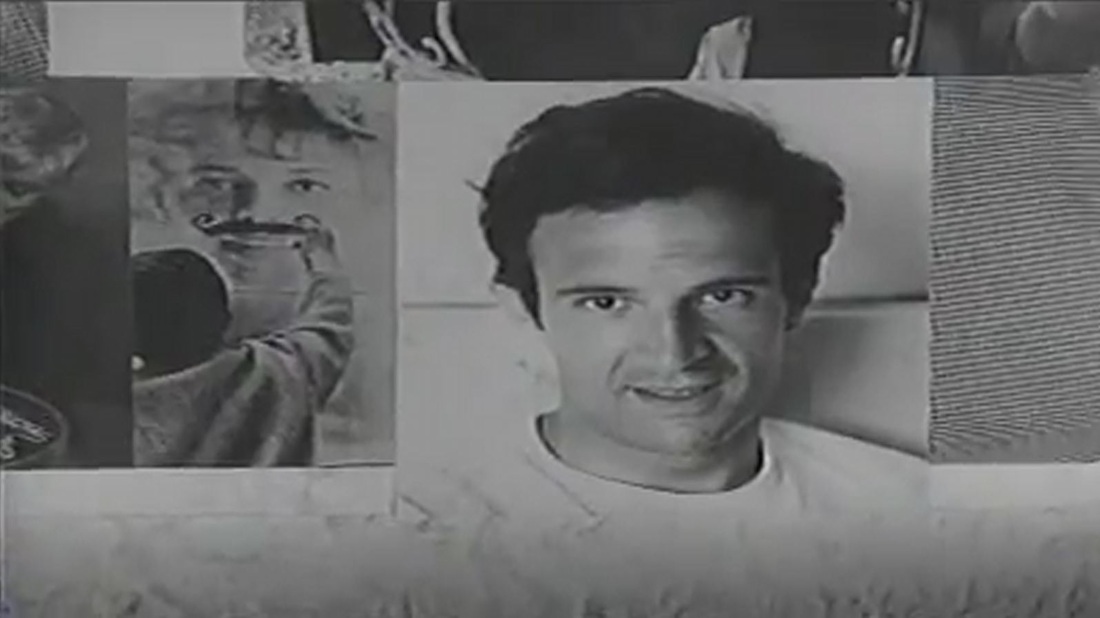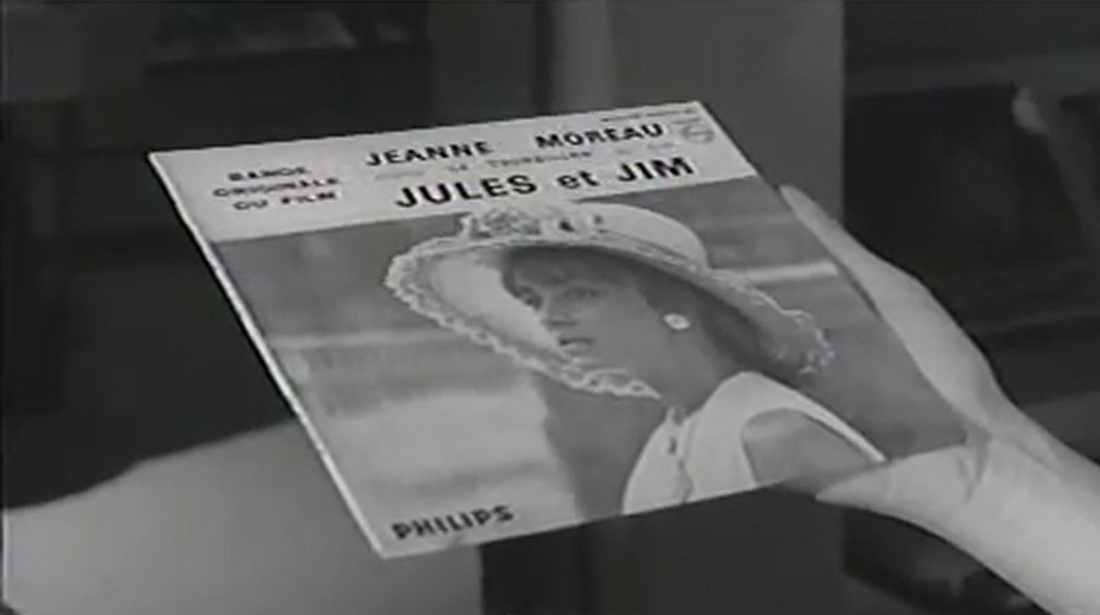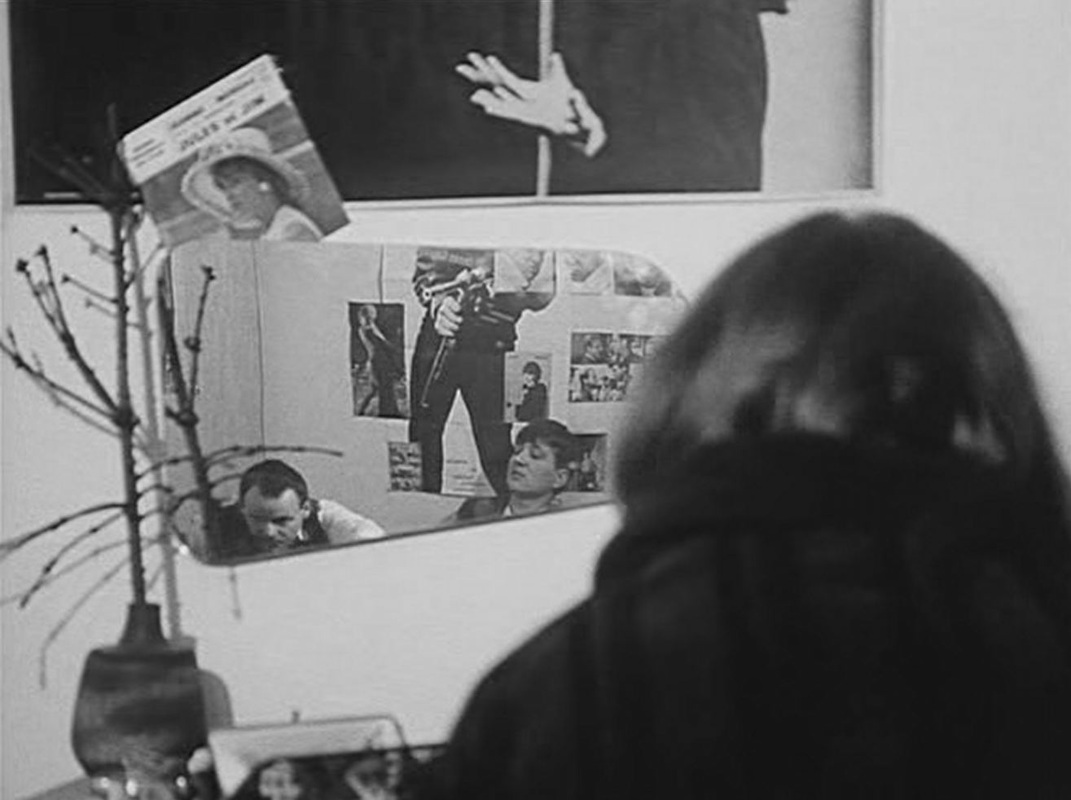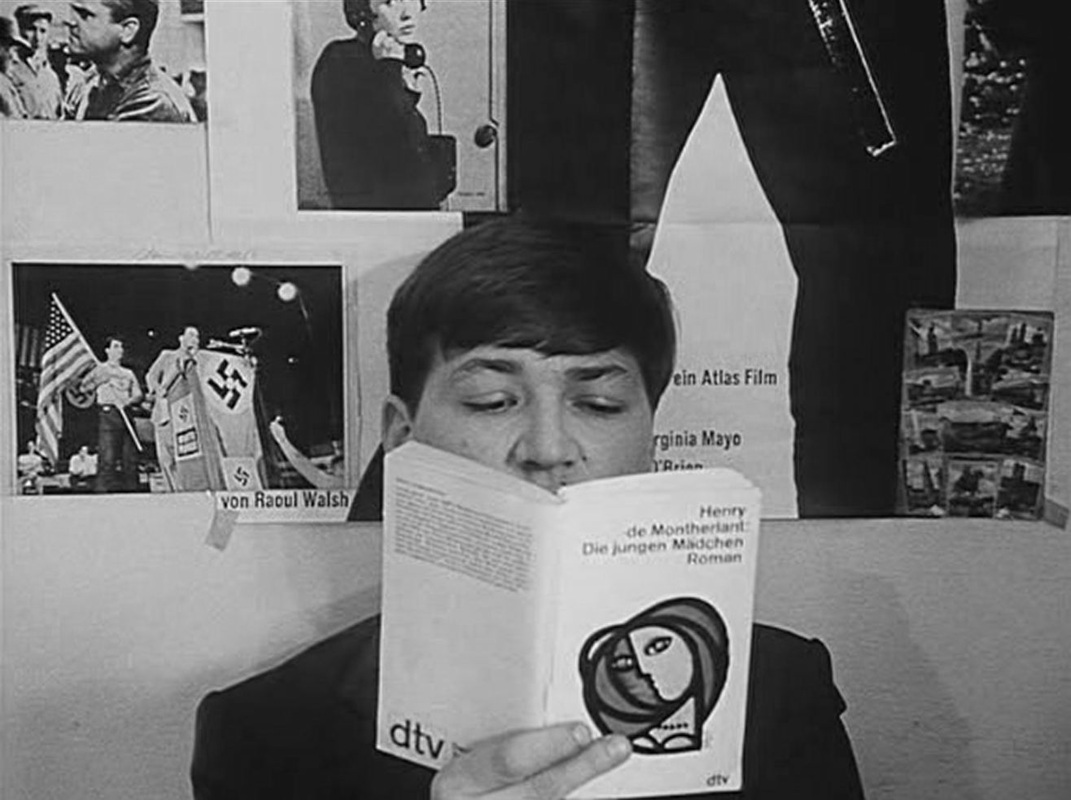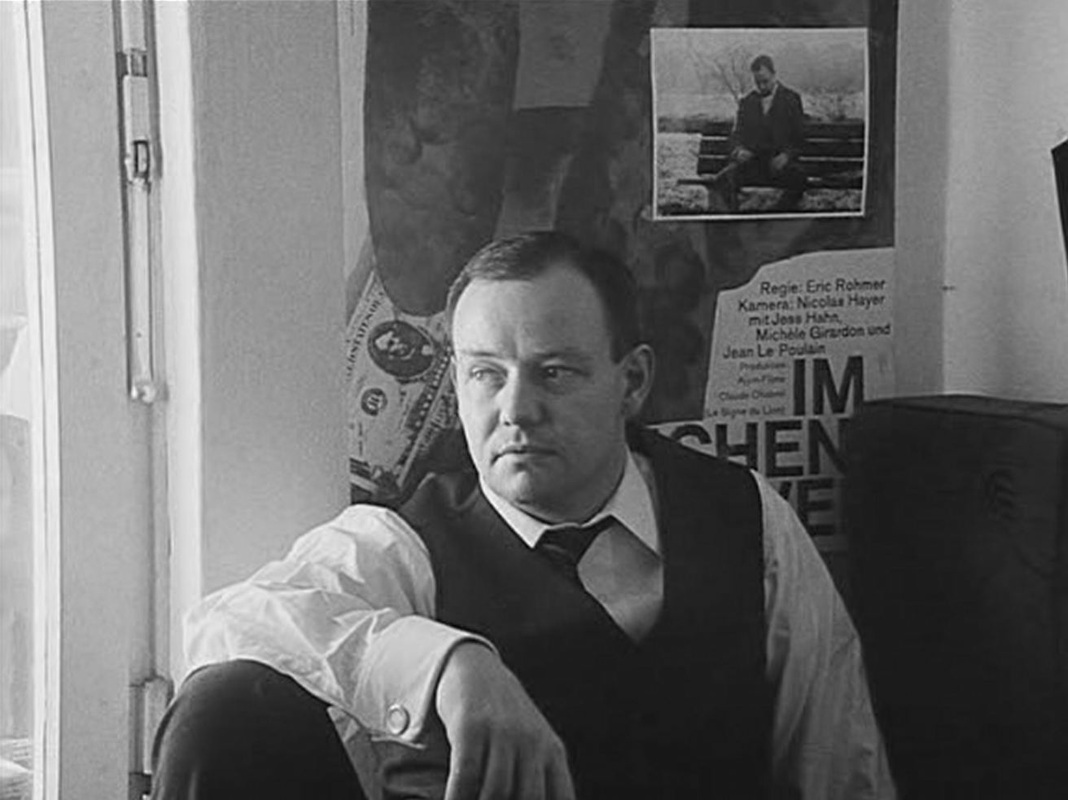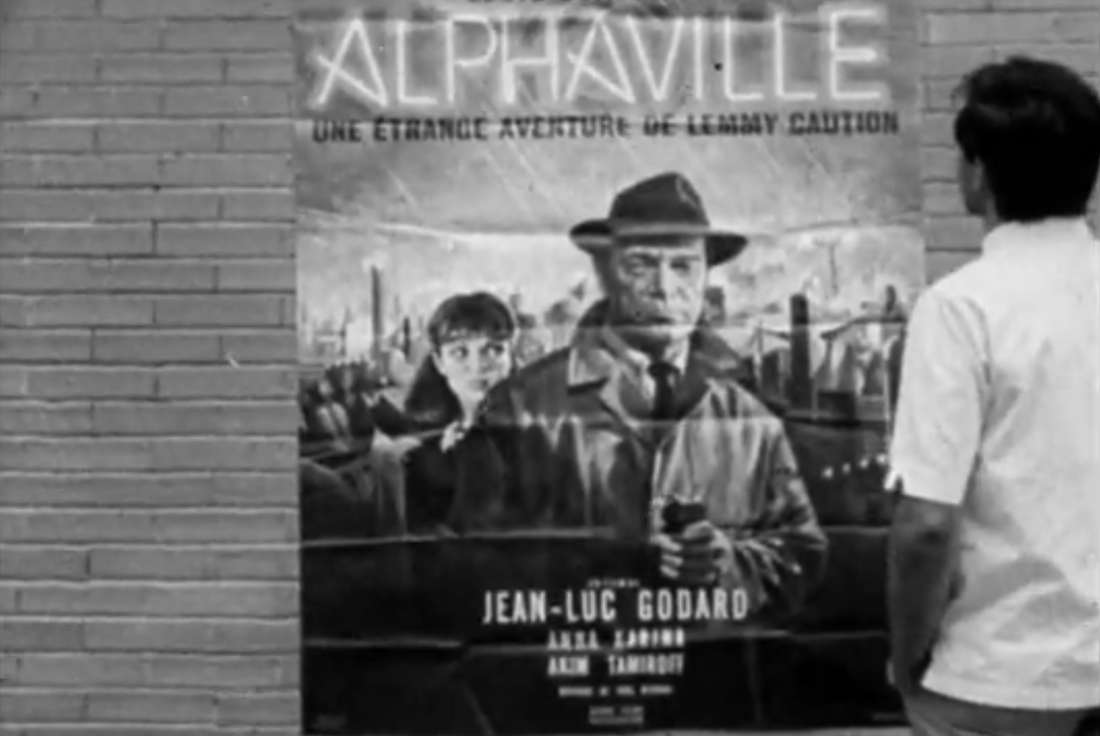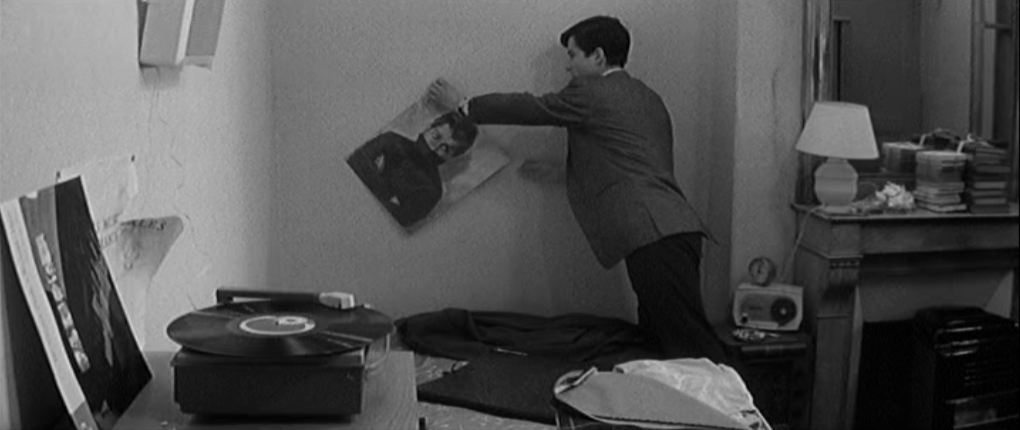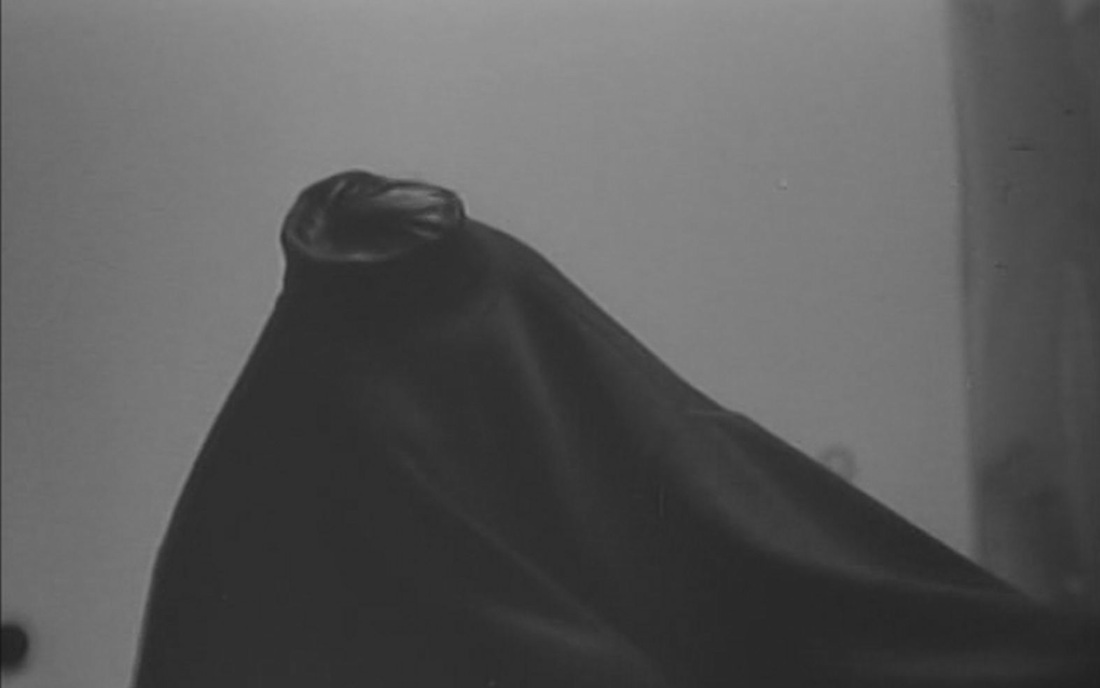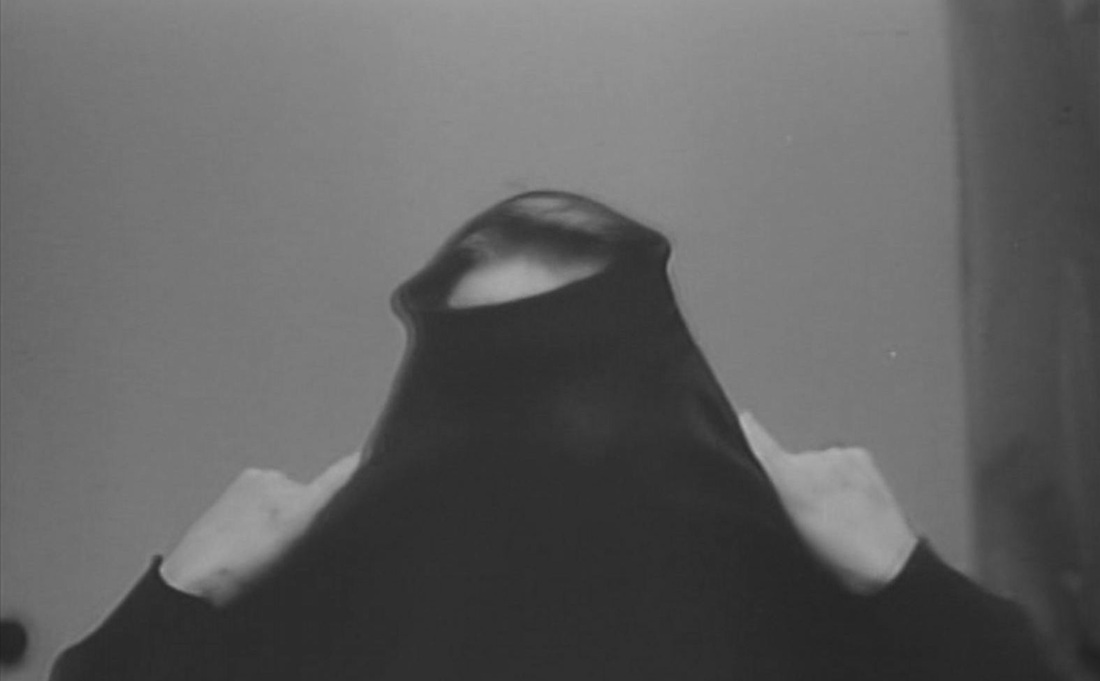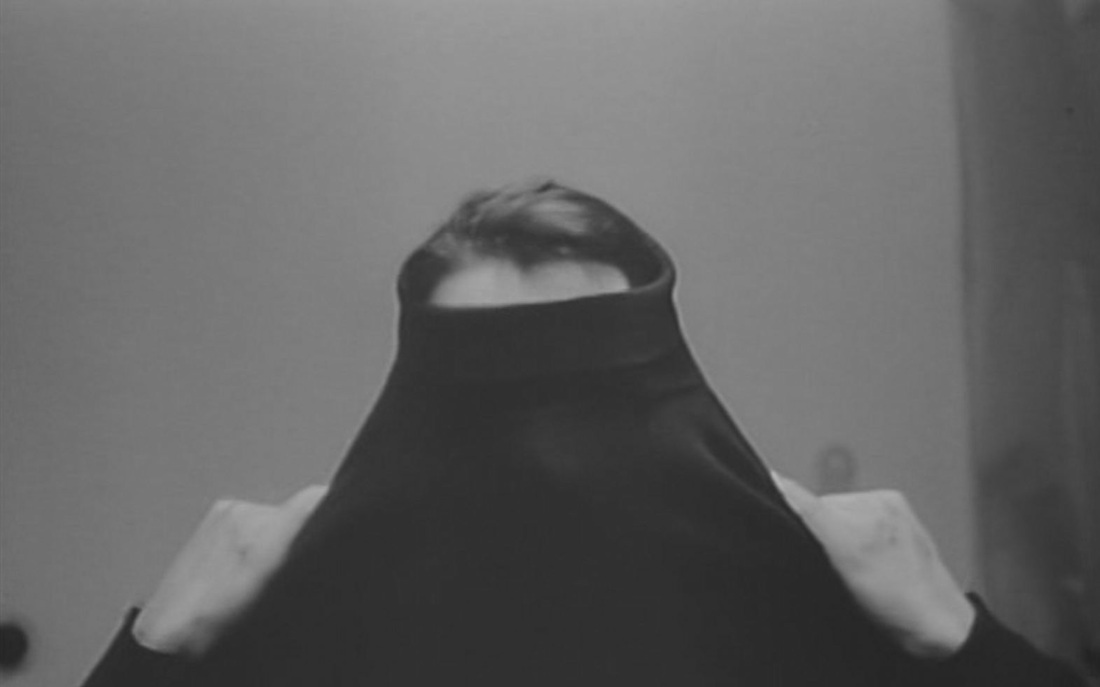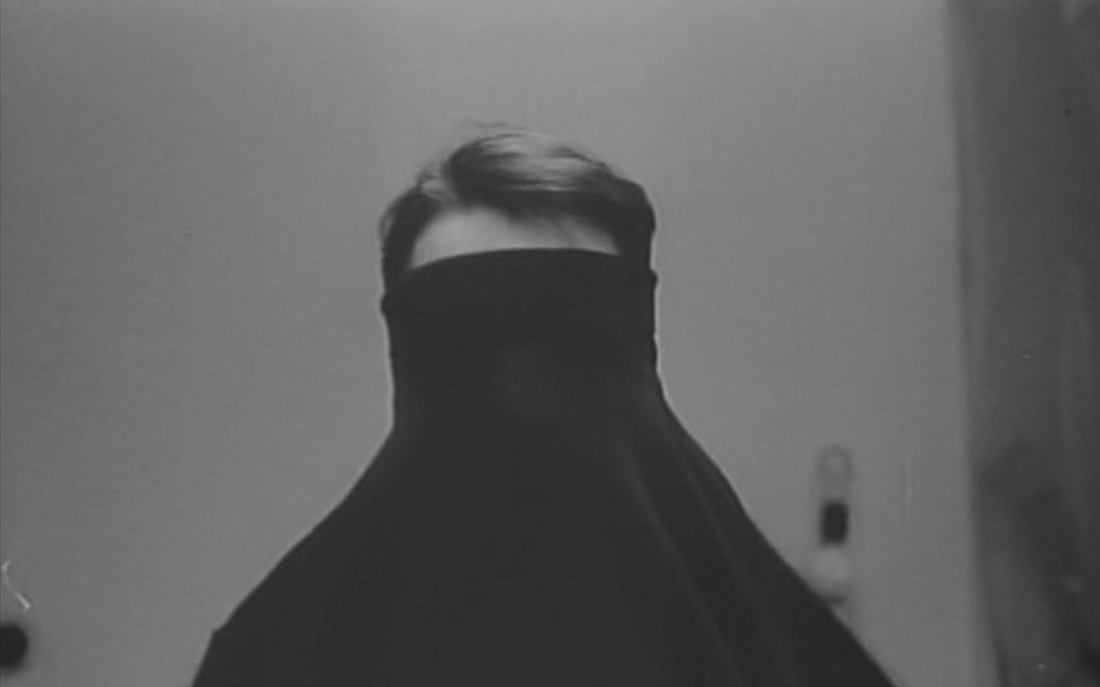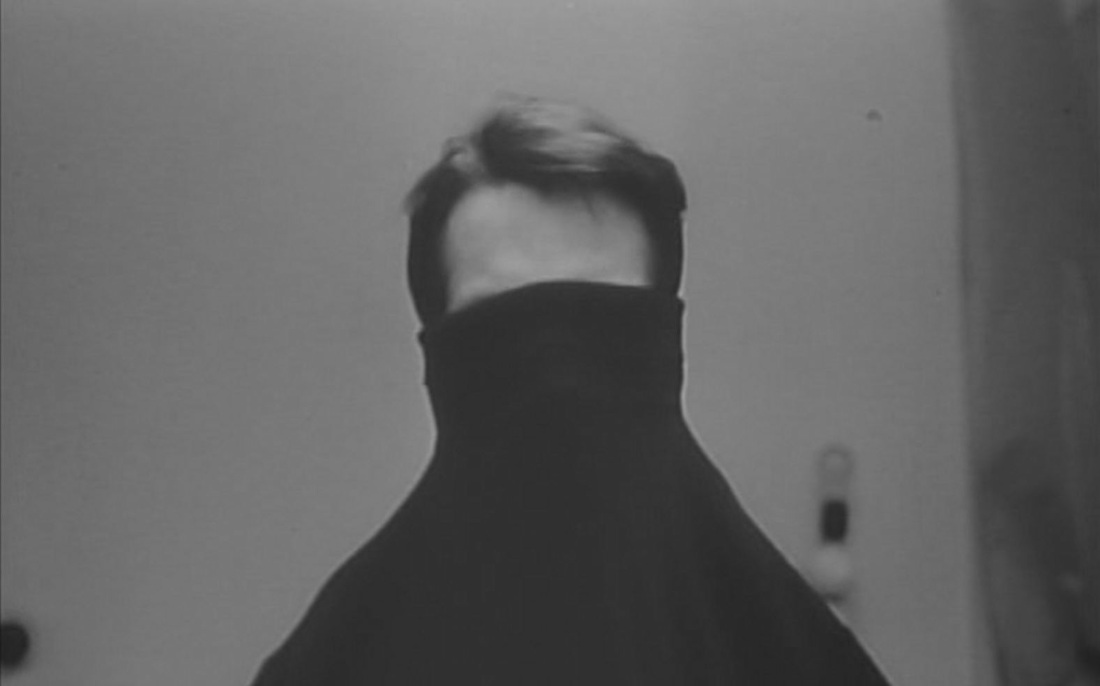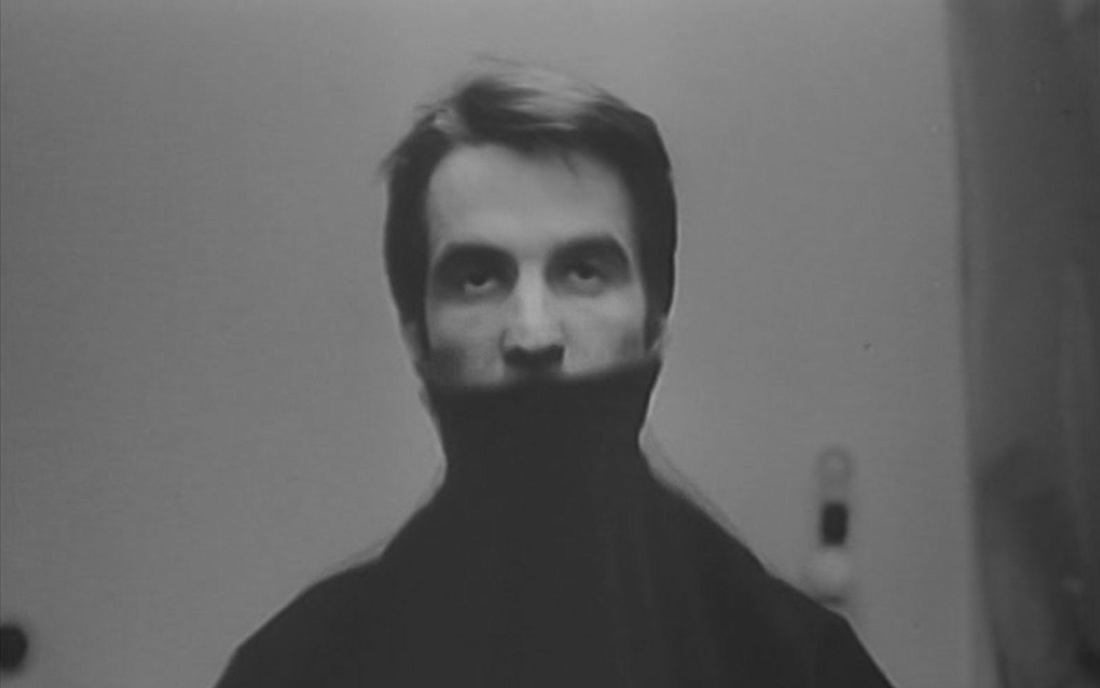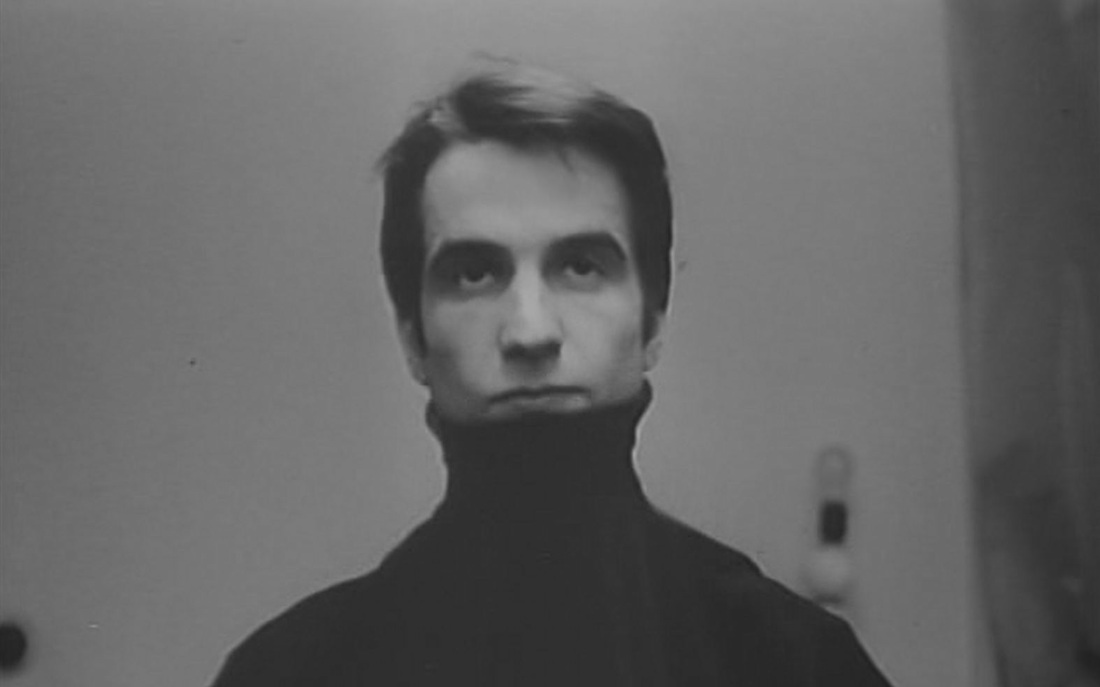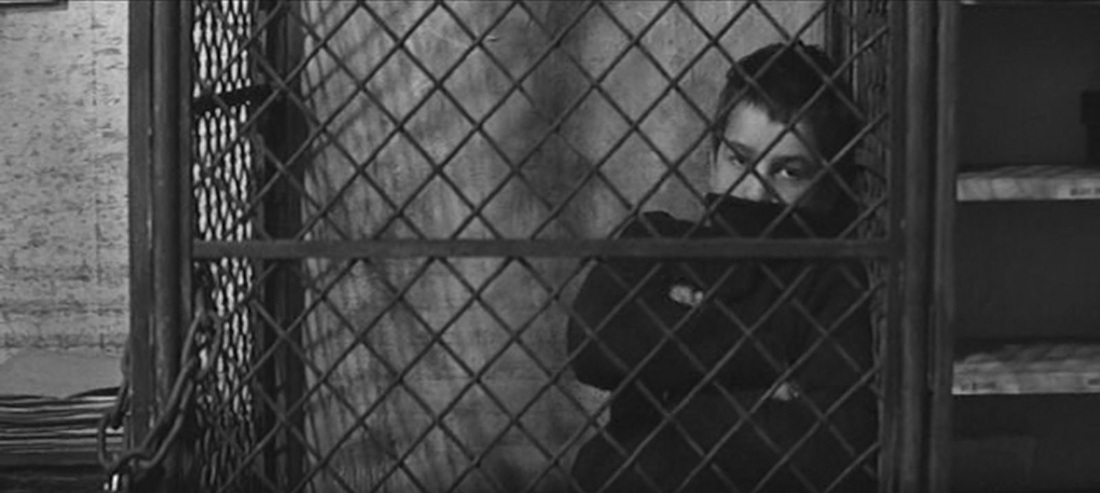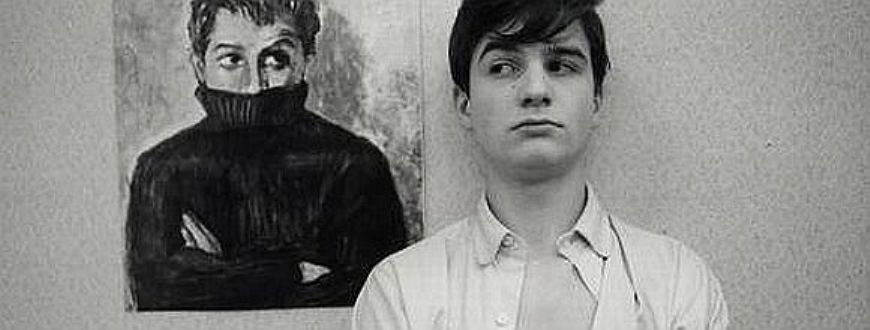This is a post about mentions of New Wave films in other New Wave films.
In his 1956 short Les Mistons Truffaut brings his characters to the cinema, where they are seen watching Rivette's Le Coup de berger, from the same year:
It seems unfeasible that this film would be playing alongside the main feature we see announced outside the cinema, Ihr Leibregiment - 'La Princesse et le Capitaine' - a romantic comedy from West Germany:
Unfeasible but not impossible. The next time Truffaut has a Rivette film playing in one of his own, Les 400 coups (1959), it is quite impossible. Famously, the Doinel family go for a night out at the Gaumont Palace to see Rivette's Paris nous appartient, a film which wouldn't be finished for almost two years. The film actually playing at the Gaumont Palace is Léo Joannon's Tant d'amour perdu (1958), an old school film that, curiously but coincidentally, has as second female lead Anne Doat, who had been second female lead in Le Coup du berger:
In 1957 Truffaut himself was referenced in a novel way by another New Wave filmmaker. In Godard's Tous les garçons s'appellent Patrick, a conversation between two protagonists at a café terrace is overheard by a man reading the weekly journal Arts (15 May 1957), on the front page of which is Truffaut's polemical essay attacking the 'false legends' of French cinema:
The still on the journal's front page is from Fellini's Nights of Cabiria and is unconnected to the Truffaut essay. I would, however, like to know the connection between the man reading the journal and the French New Wave c. 1957. He looks familiar but I can't put a name to him:
Any suggestions (here) would be much appreciated.
Truffaut's films are much more frequently cited than his essays. He sets the pattern himself in his sequel to Les 400 coups, where Antoine Doinel moves into a new hotel room and puts on the wall a poster of himself from the earlier film:
Truffaut's films are much more frequently cited than his essays. He sets the pattern himself in his sequel to Les 400 coups, where Antoine Doinel moves into a new hotel room and puts on the wall a poster of himself from the earlier film:
Four years later, in Godard's Masculin Féminin, a character played by the same actor - Jean-Pierre Léaud - pretends to be 'General Doinel' in order to get a military car to come collect him and his girlfriend. (She doesn't believe him when he says he's stolen a car, saying that only men like Pierrot le fou did that sort of thing.)
The same year, in Jean Eustache's Le Père Noël a les yeux bleus, Léaud looks at a poster of himself in Les 400 coups outside a cinema:
The same year, in Jean Eustache's Le Père Noël a les yeux bleus, Léaud looks at a poster of himself in Les 400 coups outside a cinema:
Before that, Jacques Doniol-Valcroze had shown his film-producer protagonist in La Dénonciation (1962) with a still from Les 400 coups on his office wall:
In that office he also has a poster for Jean Rouch's La Pyramide humaine (1961), a film produced by Pierre Braunberger, the producer of La Dénonciation:
That is Nicole Berger, stepdaughter to Braunberger and a star of Truffaut's Tirez sur le pianiste (1960), also produced by Braunberger. Perhaps this is Braunberger's office, but his office is recorded as the location for the police station in Godard's Vivre sa vie - produced by Braunberger in 1962 - and the two offices don't look much alike. In the office in Vivre sa vie, however, there is a curious citation of Tirez sur le pianiste. Behind the policeman at the typewriter is a photograph:
This must be related somehow to Truffaut's film, because it shows a scaled down version of the poster of poses that draw the attention of that film's timid protagonist:
The photograph in the police station is a very oblique reference to Truffaut's Tirez sur le pianiste. More direct is the reference in Vivre sa vie to Truffaut's Jules et Jim (1962):
In Une femme est une f emme (1961),Godard had already mentioned Jules et Jim - while it was still in production. Jeanne Moreau has a cameo role and is asked by Belmondo 'How's it going with Jules and Jim?':
Moreau's answer is 'Moderato...', evoking the para-New Wave film she and Belmondo had appeared in together, Peter Brook's Moderato cantabile (1960).
A poster for Une femme est une femme appears in a café in Vivre sa vie:
A poster for Une femme est une femme appears in a café in Vivre sa vie:
The poster to the left is for François Reichenbach's L'Amérique insolite (1960) - another Braunberger production. The poster in the middle is for Kon Ichikawa's 1959 film Nobi (Fires on the Plain) - my thanks to Yiwen Luo for the identification.
Later in Vivre sa vie Karina is standing in front of posters for Robert Rossen's The Hustler (1961), Melville Shavelson's On the Double (1961) and Otto Preminger's Exodus (1960). In the top left corner can just be seen the edge of a poster for Tire au flanc '62, directed by Claude de Givray with help from Truffaut:
Like Vivre sa vie, Une femme est une femme enjoys referencing other New Wave films. Earlier Belmondo had said he wanted to get to the café because they were showing A bout de souffle on tv. I've checked the schedules as thoroughly as I could and it doesn't look like A bout de souffle was on tv at any point around then - indeed I don't think it could have been, since three years had to pass before a a film could be shown on television.
Later we see a television in a shop window that is showing Varda's L'Opéra Mouffe (1958), for which three years had passed, but it does seem an unlikely televisual offering, and more like a hommage to a friend:
Later we see a television in a shop window that is showing Varda's L'Opéra Mouffe (1958), for which three years had passed, but it does seem an unlikely televisual offering, and more like a hommage to a friend:
Une femme est une femme also references Tirez sur le pianiste, at some length. Angela meets her friend and asks what she is reading. The friend mimes the title and Angela guesses correctly, adding that she has seen the film - 'Aznavour is brilliant':
Angela's friend is played by Marie Dubois, star of Tirez sur le pianiste, alongside Charles Aznavour. Later still we see a jukebox playing an Aznavour record, 'Tu te laisses aller', with the E.P.'s cover displayed, next to the cover of the E.P. from Tirez sur le pianiste:
Une femme est une femme includes a cameo from Catherine Demongeot, star of Louis Malle's para-New Wave Zazie dans le métro (1960), and sets her cameo in a bookshop showing a copy of home cinema magazine Le Cinéma chez soi, with Catherine Demongeot on the cover:
These are just gags, as befits the comic mode of Une femme est une femme. In the not-at-all comic Une femme mariée (1964), Godard refers to a Truffaut film by inserting a close-up of a magazine article (in Elle, I think) on La Peau douce, establishing a strong and serious intertextual connection between their two films - the one adultery-centred film as a riposte to the other:
La Peau douce appears again, via a Godardian connection of sorts, in Jean Aurel's De l'amour (1964). The protagonist makes home-movies of his lovers, including, here, Anna Karina in front of a poster for Truffaut's film:
In Godard's Bande à part (1964), Karina's 'peau douce' - her soft skin - is mentioned, another drop of the name of Truffaut's film.
Another of Godard's protagonists in this film whistles the theme from Jacques Demy's Les Parapluies de Cherbourg (1964), music by Michel Legrand, who also wrote the music for Bande à part.
I detect a similar, if more obscure, reference when Odile brings fresh meat to a nearby circus tiger - Claude Chabrol's upcoming film was Le Tigre aime la chair fraîche (The tiger likes fresh meat'):
Another of Godard's protagonists in this film whistles the theme from Jacques Demy's Les Parapluies de Cherbourg (1964), music by Michel Legrand, who also wrote the music for Bande à part.
I detect a similar, if more obscure, reference when Odile brings fresh meat to a nearby circus tiger - Claude Chabrol's upcoming film was Le Tigre aime la chair fraîche (The tiger likes fresh meat'):
Chabrol's film has a murderous dwarf called Jean-Luc, apparently in homage to Godard (who was not short, but was shorter than Chabrol):
This same actor plays another murderous dwarf the following year in Godard's Pierrot le fou, a memory of Chabrol's film, and perhaps of the name Jean-Luc - Marianne, played by Godard's estranged wife Karina - kills the dwarf with those scissors:
A scene at the cinema in Pierrot le fou shows us Belmondo looking at his co-star from five years before, Jean Seberg, acting in the sketch Godard made for the film Les Plus Belles Escroqueries du monde (1964) - the young man in front of Belmondo is Jean-Pierre Léaud, again:
Earlier, a poster for Godard's Le Petit Soldat (1960) had made a connection between the politics of the two films, and grounded the later staging in Pierrot le fou of the same torture method used in the earlier film:
Two years earlier, in Les Mauvaises Fréquentations, Jean Eustache had pointed to Le Petit Soldat more discretely, putting a still from the film on the wall in his protagonist's room, as well as a postcard of a painting by Paul Klee that had been discussed at length in Godard's film:
Le Petit soldat will have a later intertextual career through quotations in Bertolucci's The Conformist, Tarantino's Pulp Fiction, Denis's Beau travail and her L'Intrus. Almost every one of Godard's sixties films gets referenced by someone, somewhere.
Jacques Demy has his protagonist in Lola (1960) speak of his friend Michel Poiccard - protagonist of A bout de souffle - who was gunned down by the police. More obliquely, Alain Cavalier's protagonist in Le Combat dans l'île (1963) goes to the same hotel that features in A bout de souffle, and to the same room, no. 12:
Jacques Demy has his protagonist in Lola (1960) speak of his friend Michel Poiccard - protagonist of A bout de souffle - who was gunned down by the police. More obliquely, Alain Cavalier's protagonist in Le Combat dans l'île (1963) goes to the same hotel that features in A bout de souffle, and to the same room, no. 12:
In Fahrenheit 451 (1966) Truffaut shows a burning copy of Cahiers du Cinéma, with Jean Seberg in that hotel room on the cover:
Post-New Wave, Truffaut shows the character he plays in La Nuit américaine (1973) receiving a parcel of studies of directors: Bunuel, Dreyer, Lubitsch, Bergman, Hitchcock, Rossellini, Hawks... Among these, between Bergman and Hitchcock, is a collection of essays on Godard, with Macha Méril in Une femme mariée on the cover:
Godard himself quotes Vivre sa vie twice, firstly in Le Mépris, where an Italian poster for the film can be seen alongside posters for films by Hitchcock, Hawks and Rossellini:
In Deux ou trois choses que je sais d'elle (1966), an image from Vivre sa vie appears alongside posters for intercontinental airlines:
The conection made between two films about prostitution is an obvious one, but the image that makes the connection is very strange. It can't be a film poster, since there are no words. It looks like a painting or drawing done from the film, but the original image has been reversed:
Another New Wave connection in Deux ou trois choses is made more conventionally, with a view of the poster for Alain Resnais's Muriel (1963):
Muriel had already been playing the New Wave game of inter-reference: the theme music from Tirez sur le pianiste can be heard for a moment in Resnais's film. That seems to me like a riposte to Braunberger, since a respectful pastiche of Resnais's L'Année dernière à Marienbad had served as the film-within-the-film in the Braunberger-produced La Dénonciation:
Godard had already referenced Resnais in his debut feature A bout de souffle, with a view of a cinema playing Hiroshima, mon amour (1959), supported by Varda's Du côté de la côte (1958):
A poster for Hiroshima, mon amour can also be seen, six years later, in Eric Rohmer's Une étudiante aujourd'hui:
This is the only reference to a New Wave film that I have so far found in a New Wave film by Rohmer.
Referencing films by established New Wave filmmakers would become a device used by debutants to affiliate themselves with their older peers. Robert Enrico has his protagonist in La Belle Vie (1963) quote Rivette and exclaim that 'Paris belongs to us now'. Guy Gilles's L'Amour à la mer (1963) has a cameo by Truffaut's Jean-Pierre Léaud (see here, section 3), and shows a cinema playing Godard's Le Mépris:
Gilles also includes posters for Louis Malle's Le Feu follet and Michel Drach's Amélie ou le temps d'aimer (1961), both para-New Wave films:
Une fille et des fusils (1965), Claude Lelouch's second complete feature, is a homage to New Wave cinephilia that verges on the parodic. It shows one of its would-be criminals looking at an advertisement for the film that served as its principal model, Godard's Bande à part:
Lelouch's awful film is not really a good way to end this overview of New Wave inter-referentiality. A further post will collect New Wave references to non-New Wave films, from famous instances such as Preminger's Whirlpool in A bout de souffle to minor mentions like that of Renoir's On purge bébé in Eustache's la Maman et la Putain (1973) - the last New Wave film.
In the meantime, this post finishes with four mentions of French New Wave films by non-French filmmakers in the 60s:
In the meantime, this post finishes with four mentions of French New Wave films by non-French filmmakers in the 60s:
- Une femme est une femme in Bernardo Bertolucci's Primo della rivoluzione ['Before the Revolution'] (Italy 1964):
- Les 400 coups in Istvan Szabo's Almodozasok kora ['The Age of Illusion'] (Hungary 1964):
- Jules et Jim in Jose Luis Ibanez's Las dos Elenas ['The Two Helens'] (Mexico 1965):
This same E.P. cover can be seen in Fassbinder's Bande à part-style homage to the New Wave, Das kleine chaos (1966). In the same room is a still from Vivre sa vie and a poster for Rohmer's le Signe du Lion (1959):
Brazilian Rogério Sganzeria has one of his protagonists contemplate a poster for Godard's Alphaville in his 1966 film Documentario:
Polish director Jerzy Skolimowski's Belgian film Le Départ (1967) uses the cinematographer Willy Kurant, who shot Godard's Masculin Féminin, as well as two cast members from that film, Catherine-Isabelle Duport and Jean-Pierre Léaud. The film opens with Léaud pulling a jumper over his head, quoting in the process the image of himself from Les 400 coups that Léaud puts on his wall in 'Antoine et Colette':
For related posts, see New Wave cameos and Cahiers du Cinéma on screen.
